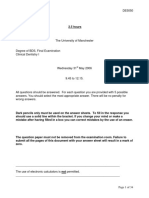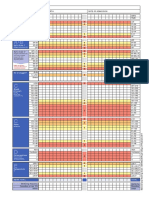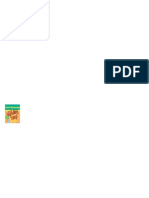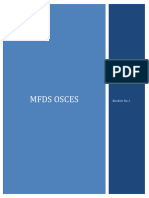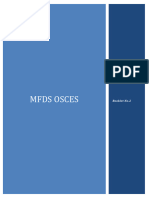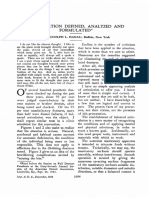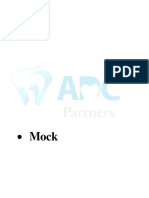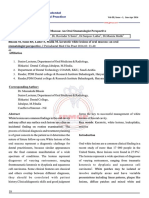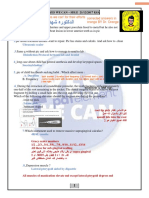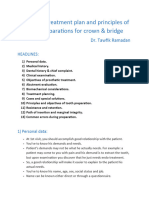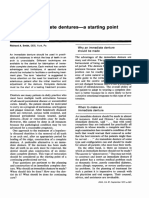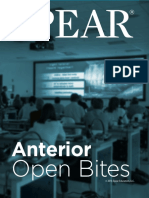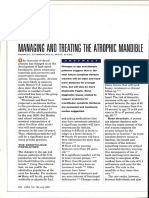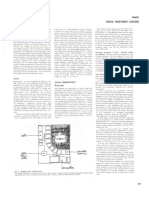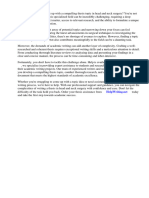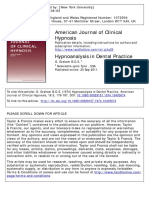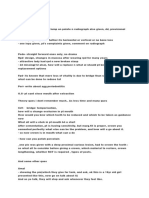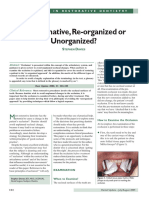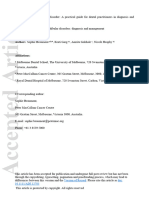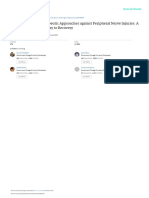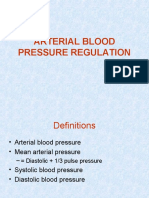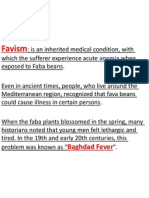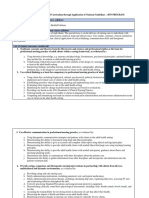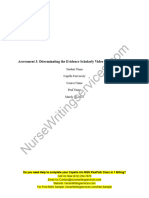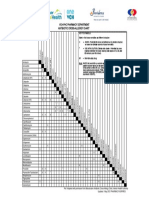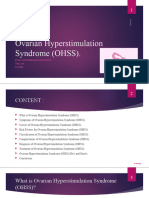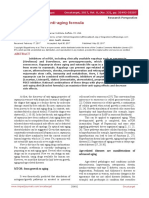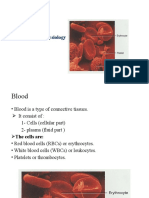MFDS OSCEs Booklet 1-6
MFDS OSCEs Booklet 1-6
Uploaded by
aqilahfrCopyright:
Available Formats
MFDS OSCEs Booklet 1-6
MFDS OSCEs Booklet 1-6
Uploaded by
aqilahfrOriginal Title
Copyright
Available Formats
Share this document
Did you find this document useful?
Is this content inappropriate?
Copyright:
Available Formats
MFDS OSCEs Booklet 1-6
MFDS OSCEs Booklet 1-6
Uploaded by
aqilahfrCopyright:
Available Formats
MFDS
OSCES Booklet No.1
Scenario - You are a GDP and have obtained the results for a biopsy you performed on a floor of mouth white
patch a week ago. Your patient is a heavy drinker and smoker. He returns for the results and says the area is
now ulcerated. The histopathology reveals dysplasia and a plasma cell infiltrate. Tell the patient what the
results mean and what you will do next
om
1) Introduce yourself to the patient
l.c
ai
2) Explain the pt about the biopsy result
gm
As you are aware that last time a sample was taken from your mouth to do some tests, I have received the
results of the tests.
@
The good thing about the result is that it's not cancerous but the bad thing about the report is that it's not something
aa
normal as well it's called something as dysplasia
h
3) Explain the pt about dysplasia et
sw
I will explain you what is dysplasia. Assume at 1 end is the normal oral mucosa and the other end is cancerous
lesion, something in between is called as dysplasia. This means that your oral mucosa is not normal and it's not
nu
cancerous as well.
.a
-N
4) Explain the pt about removing the risk factors
So you see it is in your hand weather this dysplasia goes towards cancer or it comes back to the normal side. To make this
a
condition stop progressing towards cancer you have to remove the factors which can help in getting this condition worse
ha
The two factors are your smoking habit and your drinking habit. You have to quit smoking completely and reduce your
alcohol consumption to minimum. By doing this you are helping yourself in making this condition better
et
Sw
5) Offer referral for quit smoking services
u
If you want I can refer you to quit smoking services who are trained people to help you get rid of this habit
An
1
Page
Anu Swethaa - N.anuswethaa@gmail.com
6)Explain the pt about other measures
Apart from quitting smoking and reducing alcohol consumption, you have to see th at you take care of ypur mouth properly
by brushing your teeth twice daily and keeping your mouth clean all the time
om
7)Explain management to the pt
l.c
For this problem you have 2 options
ai
Either you get it removed surgically for which I can refer you to specialist or
gm
You can just keep an eye on it and we will monitor it regularly and at any time if you noticed it is getting worse or
causing any problems you can come to us and we will refer you for surgical removal
@
8)Have you got any questions?
h aa
et
sw
nu
.a
-N
a
ha
et
Sw
u
An
2
Page
Anu Swethaa - N.anuswethaa@gmail.com
Scenario - Pt complains of loose upper denture opposing natural lower incisors. How will you manage the
looseness of the denture?
Manage the looseness of the denture?
om
l.c
ai
gm
Patient with Denture in the mouth
@
h aa
et
sw
nu
Picture of the maxilla
.a
-N
1) Introduce yourself to the pt
a
ha
2) Take concise history about the problem by asking questions like :
Since when you noticed that your denture is getting loose
et
Is it metal or plastic denture?
Sw
In your lower jaw is only your front teeth are present
Do you notice that your upper jaw feels little bit soft or swelled up
u
An
3
Page
3) Explain the reason for looseness
Anu Swethaa - N.anuswethaa@gmail.com
The reason for the looseness of your upper denture is because it is suffering from a problem called flabby ridge which is
nothing but deposition of fibrous tissue in your upper jaw. Because of deposition of this tissue your upper denture is
getting displaced giving you this feeling of looseness.
This has happened because you are wearing a complete upper denture opposing lower natural teeth. This condition has
om
got worse because the lower jaw has only front teeth present and the back ones are missing. Because of this your upper
denture did not have a stable bite causing more pressure and irritation to your upper jaw leading to this flabby ridge
l.c
4) Explain the need for replacing lower posteriors
ai
gm
First of all you have to replace the lower. back teeth so that the upper denture will have stable contact with your lower
teeth and this will be the first step of your treatment
@
aa
5) Explain the pt about new denture and options
h
The next thing is that we have to change your upper denture and make a new one so that the problem of looseness is
solved. But the new denture is done after we removed the fibrous tissue surgically or we use some special impression
et
technique to take measurement of your upper jaw and then construct a new denture
sw
6) Give the advantages and disadvantages of both the options
nu
.a
The advantage of surgical procedure is it can remove all the fibrous tissue but the disadvantage is it will reduce the jaw
size and may cause poor fit of denture
-N
The advantage of specialized impression technique is that no surgery is involved but the disadvantages it might not give
good results
a
ha
7) Have you got any questions?
et
Sw
u
An
4
Page
Anu Swethaa - N.anuswethaa@gmail.com
Scenario - 12 yr old pt had his front teeth avulsed recently. Tooth was re-implanted and splinted within a hr.
Splint was placed for 2 weeks. Explain to pt's mother the short and long term prognosis of the tooth.
1) Introduce yourself to the patient
om
l.c
2) Explain short term complications
ai
As you are aware that we have splinted the tooth ie joined them with adjacent teeth for 2 weeks. A fter we remove it there
are some short term complications like even though the chances are less because the success rate of splinting within the
gm
first hour is 80%
The tooth might not stabilize and can be wobbly and in this case we might need to remove it - The tooth can
@
become non vital and in that case we need to do root canal treatment
The tooth can become infected and present with pain and again we have to do root canal treatment
h aa
3) Explain long term complications
et
There are certain complications that can arise after few months to few years later on
The root of the tooth can resorb which means it gets eaten away and if this happens we either need to do root
sw
canal treatment if it's not severe and if severe than the tooth will fall off
The other complication can happen is that tooth can stick to the jaw bone a term we called ankylosis. If this
nu
happens we can either leave it or remove the tooth if it is causing any complications
.a
-N
a
ha
et
Sw
u
An
5
Page
Anu Swethaa - N.anuswethaa@gmail.com
Scenario - Pt was recently diagnosed with cancer of the tonsils. Pt is scheduled for radiotherapy soon.
Explain to the pt the likely complications of radiotherapy on his oral cavity
1) Once the radiotherapy is started it effects the oral mucosa (skin of the mouth) causing inflammation and ulceration
om
which is called as mucositis
l.c
The oral mucosa appears red and there will be difficulty in eating and speaking
ai
For relief of this condition you need to keep the area clean and if needed analgesic mouth wash
gm
@
2) The most common complication is dry mouth which develops usually during the course of radiotherapy
aa
Advice the pt about managing the problem
h
et
Drink plenty water and take small sips of water throughout the day.
sw
Stimulate saliva with sugar free chewing gums.
- Always take water or non alcoholic drinks with meals and rinse with water after meals.
nu
- Avoid dry or hard foods such as biscuits, but you can eat soft creamy foods, soups or foods with high liquid content
.a
such as melon and grapes.
-N
The dryness will improve after some time as the radiation effect goes down. You might see improvement in your
condition overtime
a
ha
3) It affects the taste buds resulting in disturbance in taste sensation
et
Sw
4) It can increase the chances of having Candida infection especially if you are wearing dentures
u
An
5) The radiation can effect the jaw bones resulting in damage to the bone cells which increases the risk of bone
fractures
An important complication can be seen after extraction of tooth the area of bone will not heal and this condition is called
osteoradionecrosis
6
Page
Anu Swethaa - N.anuswethaa@gmail.com
To avoid this risk you should take care of your teeth by brushing them regularly and visiting Dentist and in this way
avoids tooth removal
Radiation cause dry mouth which increases the risk of dental caries, so protect against caries by Reducing sugar
intake Avoid sticky foods
Keeping mouth clean (brushing twice daily)
om
Brushing with fluoride tooth paste
Use fluoride mouth wash
Regular dental check up.
l.c
ai
6) Radiation in a way increases the risk of gum disease and to protect against gum problems and bad breath by flossing
regularly
gm
@
h aa
et
sw
nu
.a
-N
a
ha
et
Sw
u
An
7
Page
Anu Swethaa - N.anuswethaa@gmail.com
Scenario - A 16 year old female presents having avulsed upper central the night before, about 12 hours have elapsed
and the tooth has been stored dry in a packet since the accident. She is a bridesmaid at a wedding in 3 months time.
Take the history and give treatment options.
om
l.c
ai
1) Introduce yourself
gm
2) Take the history about accident
When did it happen?
@
Did any other teeth receive trauma
Did you lose consciousness?
aa
Any trauma to head area
h
3 ) E x pl a i n the poor pr og nos i s et
In some cases we can place the tooth back and splint it but unfortunately in your case it is not possible because of 2
sw
reasons. The amount of time which is 12 hrs since it came off and it was stored in a dry environment.
nu
4 ) E x pl a i n i mme di a te tr e a tme nt
.a
-N
For now I have to give you an immediate denture which will replace the area created by loss of tooth
5 ) Give definite treatment options
a
Once the area heals we can give you definite treatment options like
ha
Metal or plastic denture — They will be cheaper but they are removable option
Resin bonded bridge — Less tooth preparation is needed but the metal wing might show through Fixed bridge —
et
Better stability but tooth preparation required
Sw
u
An
8
Page
Anu Swethaa - N.anuswethaa@gmail.com
Scenario — Mr Clarke complains of food lodgment in his upper right back tooth. He is going to start bisphosphonate
therapy in 3 weeks time. How will you manage him?
om
l.c
ai
gm
@
aa
1) Introduce yourself to the pt
2) Take history about the complain
h
On which tooth the food is getting lodged
Since how long have you noticed this problem?
et
sw
What do you do to clean the food material lodged in the tooth - Do you have any pain on the tooth?
Did you had pain on this tooth in the past
nu
3) Take history about bisphosphonates
.a
For which condition are you going to start taking bisphosphonates
Are you going to take it in tablet form or is it going to be given through the vein - When are you going to start
-N
taking them?
4) Explain your diagnosis
a
ha
et
Sw
u
An
9
Page
Anu Swethaa - N.anuswethaa@gmail.com
The reason for your food lodgement is that tooth has decay and because of the decay a hole was created and your food
was getting stuck there. I am sorry to say that decay has involved the core of the tooth and un fortunately your tooth is
dead now.
There is also couple of decay in the adjacent teeth which needs to be removed as well.
om
5) Give treatment options
l.c
There are 2 treatment options for your problem
ai
The first is to extract it. The advantage is that it's a quick solution to your problem but you will lose you natural
tooth
gm
The other option is to do root canal treatment to save the tooth but it may involve referral to specialist as the
decay is present in an inaccessible area and to remove it might involve a complex treatrnent. The advantage is
@
it might save the tooth but the chances of failure is high
aa
For the other teeth which has decay we will remove it and give you a filling
h
6) Explain the risk et
sw
In your case removing the tooth may be the better option because of 2 reasons
The chances of success to save this tooth is low and if any complication develops after you have started taking
bisphosphonates it might need to be removed. In pt who takes bisphosphonate there is a risk of bisphosphonate
nu
related necrosis of jaw after tooth extraction. This is basically a condition in which your jaw bone does not receive
enough blood supply and it starts to weaken and die. The risk ranges from 1:10000 to 1:100000
.a
The success rate to save the tooth is not good because of decay in inaccessible area which may require a
-N
complex treatment and also because the bone support around the tooth is not good.
a
7) Have you got any questions
ha
et
Sw
u
An
10
Page
Anu Swethaa - N.anuswethaa@gmail.com
Scenario — Mr James Walter is a new pt to your surgery and during history taking you have found out that he is a
smoker. James has lost his upper incisor in an accident and want to replace it with implant.
om
1) Introduce yourself to the pt
l.c
2) Take a concise history about the smoking habit
ai
How soon after waking up you smoke your first cigarette?
Do you want to quit smoking for good now or in future?
gm
Have you tried to quit before?
Do you want help with your attempt to quit smoking?
@
What is the reason for your smoking is it a habit or do you smoke when you are stress or do you smoke
socially?
aa
3) Explain the pt that implant is not a good option
h
et
Smokers treated with dental implants have a greater risk of developing peri -implantitis. The formation of deep pockets
with inflammation of the pen-implant mucosa around dental implants is called periimplantitis This condition can lead to
sw
increased resorption of pen-implant bone. If left untreated, periimplantitis can lead to implant failure.
nu
4) Explain the pt about high failure rates
.a
Many research studies have shown that smoking can lead to higher rates of dental implant failure. Studies has shown
-N
that smoking may lead to higher implant failure rates by up to 50%
5) Explain the pt that refraining from smoking at least during treatment increases the success rate
a
ha
Whichever course of treatment you decide to pursue, you can expect slower healing and a greater possibility of failure if
you continue to smoke during or following treatment healing period. If you can stop smoking three to four weeks prior
et
to implant placement and remain smoke free during the healing period, results may improve.
Sw
6) Explain the pt that quitting smoking altogether is best and explain about the advantages of quitting smoking by
putting some facts in front of the pt
u
An
11
Page
Anu Swethaa - N.anuswethaa@gmail.com
-First I want you to think about quitting smoking for good. Implants can be a motivating factor
-Just to let you know that smoking is the largest single preventable cause of death and disability in U.K. Each
year smoking kills 120,000 people.
om
Stopping smoking is the single most effective step you could take to improve your present state of health
Smoking affects your oral as well as general health
l.c
ai
7) Offer referral for quit smoking services
I can refer you to NHS stop smoking service.
gm
NHS stop smoking service trained adviser will work with you either in group or one to one session to advise you
about nicotine replacement product like nicotine patch or other stop smoking medicines.
@
aa
During the sessions you can share your or listen or other people experience which is really helpful.
Or you can refer yourself for which I will give you the telephone number.
h
8) Offer alternative treatment options
et
sw
I can explain you about other replacement options like dentures and bridges if you don't want to quit smoking
nu
.a
9) Have you got any questions for me?
-N
a
ha
et
Sw
u
An
12
Page
Anu Swethaa - N.anuswethaa@gmail.com
Scenario — You are working as a associate Dental surgeon, today your appointment diary is full and you are
going to start with your first appointment. You smell alcohol on the breath of your nurse who is going to
assist in the treatment. What would you do?
1) Take the nurse away from the pt and ask if she has been drinking
Can you please come to the other room as I want to talk to you in private? I think you have been drinking as I can
om
smell alcohol from your breath. Can you please tell me is it right and what the reason is?
2) Explain the nurse about the seriousness of the matter
l.c
I want to tell you it is a very serious matter as you cannot work under the influence of alcohol, especially in our
ai
profession as a health care provider. We have to maintain the dignity of our profession and the also the nature
of our work requires us to be in our complete senses
gm
3) Explain the nurse that being drunk at work is against the contract
As you might know there is a clause in our employment contract that tells us about alcohol. The cause clearly mentions that
@
we cannot report to work under the influence of alcohol nor we can consume it during work hours. By being drunk on work
you have broken the terms of your contract of employment
aa
4) Remind the nurse about health and safety law at work
h
I also want to remind you that your behaviour is against the health and safety law. This law is for your safety as well as
patient safety. If you are drunk you might not be very careful with instruments and might injure yourself or might also
et
accidentally prick on used needles. From pt point of view his safety is also compromised be cause you are not
performing your job properly
sw
5) Warn the nurse that she is putting her registration at risk
nu
The most important thing is your registration is at risk as the GDC has clear rules regarding working under the influence
of alcohol. The GDC in these cases usually go to the professional standards committee who has the authority to either
suspend you temporarily or permanently
.a
6) Explain the nurse what you will be doing now
-N
I know we are all human beings and mistakes can happen with anyone. It's nothing personal but it's my duty to inform
the practice manager about this incident. I am sorry if because of my complain you are going to face any problems, I
a
am just doing my job.
ha
7) Inform the nurse that she can't assist you
et
I am sorry I need to start the treatment with a different nurse which I think is the right thing to do under these
Sw
circumstances
u
An
13
Page
Anu Swethaa - N.anuswethaa@gmail.com
Scenario - Mr Norman is a heavy smoker with advanced periodontal disease. You had to
counsel and advice regarding behavioural change—specifically giving up cigarettes
1) Introduce yourself to the pt
om
2) Take a concise history about the smoking habit
l.c
How many cigarette you smoke every day and for how long you are smoking.
ai
How soon after waking up you smoke your first cigarette?
gm
Do you want to quit smoking for good now or in future?
Have you tried to quit before?
@
Do you want help with your attempt to quit smoking?
What is the reason for your smoking is it a habit or do you smoke when you are stress or do you smoke
aa
socially?
h
3) Explain the pt link between smoking and periodontitis
et
As you are aware that you suffer from gum disease, and for every problem there is a reason. Your smoking habit is a
risk factor for this gum problem. Smoking reduces your body ability to fight infections, smokers shows less response
sw
to treatment and they have reduced blood supply to gums.
nu
4) Explain the pt about the advantages of quitting smoking by putting some facts in front of the pt
.a
First I want to congratulate you for showing interest in quitting smoke
-N
Just to let you know that smoking is the largest single preventable cause of death and disability in U.K. Each year
smoking kills 120,000 people.
Stopping smoking is the single most effective step you could take to improve your present state of health
a
Smoking affects your oral as well as general health
ha
et
5) Explain the pt about disadvantages if the pt continues to smoke
It says that half of current smokers will die of smoking related diseases
Sw
It can cause stained teeth, bad breath and oral cancer. It says smokers are 4 times likely to suffer from oral
cancer than non smokers.
u
An
14
Page
Anu Swethaa - N.anuswethaa@gmail.com
-It can cause lung cancer and heart disease to name a few. - --And people around you will be affected by the
smoke as well
6) Give the pt some tips on quitting smoking
om
You should not feel dejected by your past failures in quitting smoking.
l.c
But it actually improve your chances of quitting smoking as people who keep on trying to quit are more likely to
quit smoking in the end.
ai
Try to set up a deadline and stick to it.
gm
I will suggest you to take help from your family and friends in this matter.
@
7) Offer referral for quit smoking services
aa
I can refer you to NHS stop smoking service.
h
et
NHS stop smoking service trained adviser will work with you either in group or one to one session to advise you
sw
about nicotine replacement product like nicotine patch or other stop smoking medicines.
nu
During the sessions you can share your or listen or other people experience which is really helpful.
Or you can refer yourself for which I will give you the telephone number.
.a
-N
7) Have you got any questions for me?
a
ha
et
Sw
u
An
15
Page
Anu Swethaa - N.anuswethaa@gmail.com
Scenario — You have taken a periapical radiograph for Mrs Green but unfortunately its very light. So take consent for
a repeat radiograph from Mrs Green who is not happy because of extra radiation with a repeat radiograph.
om
l.c
ai
gm
@
1) Introduce yourself to the pt
aa
2) Explain the pt why you want to take a repeat radiograph
h
I am sorry to say that we have to take one more radiograph as the last one which was taken is not of good quality as the
part of tooth which we need to visualise is missing. et
sw
If we don't take the radiograph it will be difficult for us to diagnose your problem and if we are not able to diagnose
it properly then we won't be able to treat it effectively as well.
nu
.a
3) Address pt concerns
-N
I totally understand your concern about the effect of the extra radiograph. I will try to put some facts in front of
you.
I just want to say you that as a health care provide we always try to work in the best interest of our patient and
a
we will never do anything which will harm our patient or put them under any risk.
ha
First of all before we take any radiograph we follow the recommendations put forward by international
commission on radiological protection, and they say that
et
There should be a justification to take radiograph and in your case we need it to diagnose your problem and
treat accordingly
Sw
u
An
16
Page
Anu Swethaa - N.anuswethaa@gmail.com
The radiation dose should be kept as low as possible. To achieve this we use latest x-ray machines, fast x-ray
films and direct the radiation on the area of interest only
Regarding your concern of cancer, the risk of getting cancer is very low, its 1 in 2 million to 1 in 20 million for 10PA
om
4) Explain the pt that dose of 1 radiograph is very negligible
l.c
According to ionising radiation medical exposure regulation, any patient should not be exposed to more than
ai
(lmsv) amount of radiation in 1 year. This is equivalent to more than 125 intra oral, so you can see by taking 1
extra radiograph will not cause you any problem
gm
Secondly the amount of background radiation we receive in this country every year (2.6msv) from travelling in a
car, sitting in front of television, using mobile and laptop is equivalent to more than 350 intra oral radiograph, so
@
you can see the dose of an extra radiograph is very minimal
aa
5) Explain the pt the measures you are going to take to prevent this happening again
h
I again apologize to you for taking a repeat radiograph. To prevent this happening in the future we take some measures.
et
Firstly we regularly review the rejected films for analysis of its faults and do take steps to reduce the number of
sw
pour quality films.
Secondly we conduct routine tests of the x-ray machine every 3 years by authorized engineers to prevent
nu
malfunction of the machine causing poor quality radiographs, thus decreasing number of poor radiographs and
repeat radiographs.
.a
Thirdly all the staff including me received proper training to take radiograph and we receive regular
training to improve our knowledge and skills thereby presenting poor quality and repeat radiographs.
-N
If any fault happens we do a proper audit regarding the fault to prevent it happening in the future and also
work on the measure to prevent it happening in the future.
a
ha
et
Sw
u
An
17
Page
Anu Swethaa - N.anuswethaa@gmail.com
6) Take the consent from pt for repeating a radiograph
So I want to assure you that this repeat radiograph will not cause any harm to you and we do admit that a
mistake was done and as I told you we have measures in place to prevent this happening to any patient and you
in the future.
I will record about this repeat radiograph in your notes and also in practice log book about it including the
reason of the fault.
om
And please remember we always work in the best interest of our patients
So can I have your permission to take the repeat radiograph?
l.c
ai
7) Do you have any questions for me?
gm
@
h aa
et
sw
nu
.a
-N
a
ha
et
Sw
u
An
18
Page
Anu Swethaa - N.anuswethaa@gmail.com
Scenario — You have sent Mr James to oral and maxillofacial surgeon for an excisional b iopsy of a soft swelling
present in between the upper centrals. You are suspecting it to be pyogenic granuloma. Unfortunately the report
for biopsy is lost from your surgery, may be destroyed with junk letters. Explain the pt about this problem.
om
1) Introduce yourself to the pt
l.c
2) E x p l a i n w h a t h a p p e n e d
ai
I am sorry to say Mr James that the report of your biopsy result which was send to us by the specialist is lost.
I want to apologize you, I assume that the report was accidentally destroyed with other junk letters in the Paper
gm
shredder.
@
3) Explain the pt what will happen now
aa
For your biopsy the full swelling was surgically removed so unfortunately there is nothing left there for
h
taking another sample for biopsy to find out the reason for your swelling.
et
But please don't worry, because the swelling appears to be innocent as I was suspecting it to be pyogenic
sw
granuloma which is nothing but an overgrowth of your gum due to irritation.
But still we send you for a biopsy because it is a protocol which we need to follow - So we won't be
nu
sending you for a repeat biopsy.
.a
-N
4) Explain the pt how you will manage him
We will try to contact the hospital where your biopsy was done to find out if they have a record of it so that
a
ha
we can find the report for your swelling
If we can't find it then it is our responsibility to take care of you
et
We will call you regularly to monitor you to see if the swelling appears again, how is the condition of your
Sw
gums
- I want to assure you that nothing to worry about it as the swelling is already removed and we were not
u
suspecting it to be serious
An
19
Page
Anu Swethaa - N.anuswethaa@gmail.com
5) Explain the pt how you will prevent this happening again
To prevent this happening again we will do an internal enquiry to find the exact reason for the lost report
We will be doing audit about this problem to come up with steps to prevent this happening again
om
6) Document this and advice the pt about complain procedure
We will document this incident in our practice log book and also in your notes
If you want to make a complain I will ask my practice manager to speak to you who can help you further
l.c
with the procedure
ai
gm
7) Have you got any questions?
@
h aa
et
sw
nu
.a
-N
a
ha
et
Sw
u
An
20
Page
Anu Swethaa - N.anuswethaa@gmail.com
Scenario - 10 year old pt present to you with multiple caries. Diet chart given, need to give diet
advice
8am — Breakfast of cereal with added sugar and orange juice 11am — Jam
om
Biscuits
l.c
12 noon — Lunch of fish and chips with tomato ketchup 3pm — Bar of
ai
chocolate
gm
4pm- Cake with apple juice
5pm — Bag of toffee
@
7 pm — Dinner of sausage roll and bean on toast
aa
8pm — Ice cream
8.15 pm — Bed
h
et
sw
nu
1) Introduce yourself to the pt and his mother
.a
2) Take a brief history
-N
Can u tell me why your dentist asked u you to fill this diet chart?
Before I go to giving advice, can you please tell me
Who prepares the food
a
Do you check labels on food before you buy them?
ha
Do you give your child pocket-money and if yes do you know on what things your child spends them.
et
Sw
3) Explain the reason for giving advice
Before i go to giving you advice regarding this diet chart which you have filled, I want to tell you the reason for
which we have asked you to fill this chart.
u
The reason is to assess how much sugar your child is consuming and also the frequency, so that I can
An
assess your child weather he is at risk of having tooth decay.
21
Page
Anu Swethaa - N.anuswethaa@gmail.com
The aim of this advice is to see that your child reduces the intake of sugar and also ha ve a balanced diet.
4) Give advice
The most important thing is the frequency of sugar intake because sugar when eaten in any form is acted by
om
bacteria in the mouth converting them into acids and these acids starts the process of decay. The frequency is
important because, the more frequent intake means more attack on the tooth thus increasing the risk of decay.(
From the chart you can see that your child is consuming sugar many times in a day and this needs to come
l.c
down.)
Ideally the sugar should be limited to meal times and should not be consumed more than 4 times a day.
ai
Second thing is the gap in between sugar consumption. This is important because the attack on the tooth occurs
for up to 1 hour after any consumption of sugary food so ideally there should be gaps in between sugar
gm
consumption which give time for your teeth to recover.
Third thing is the quality of sugar intake is to be reduced. Ideally your child should not consume more than
@
35gram sugar per day as its not good for oral as well as general health. ( From the chart I can see that your child
is consuming a full bar of chocolate which can be reduced to half or 2 teaspoon of sugar in milk can be reduced
aa
to 1 teaspoon.
From the chart I can see that there are some food which you might not be aware that it contains sugar. For eg
h
cereal, ketchup, beans.
- From the diet I can see that there are some food which are high risk for developing decay as they stuck
to the teeth for longer time
et
sw
eg chocolates, cakes, biscuits, pastries, fruit pies, pudding, jam, honey, ice-cream
- The other thing is consumption of carbonated drinks which contains large amount of sugar. You can
substitute for plain water or milk which is also good source of calcium which is good for your child
nu
bones.
- I can see that your child is taking ice cream before going to bed. Ideally no sugar should be consumed for
.a
upto 1 hour before going to bed as saliva or spit in our mouth is produced in fewer quantity when we
-N
sleep and this saliva is beneficial because it clears away the food from mouth and reduces the acid
production from sugars.
a
ha
et
Sw
u
An
22
Page
Anu Swethaa - N.anuswethaa@gmail.com
5) Take medical histor y
Does your child take any medications and if yes are they sugar free
6 ) Comment on balanced diet
om
From the chart I can see that your child is not having balanced diet as its important because your child is growing and
balanced diet will provide all the nutrients that your child require to have balanced diet you should give your child
l.c
Eat 5 fruit and vegetable per day
Eat 2 portions of fish per week
ai
Cut on saturated fats which present in burgers, sausages, butter
Eat less salt
gm
Drink 6-8 glass water every day
@
7) Explain about ways to reduce caries risk
aa
Things you can do to reduce the caries risk is
h
et
Check food labels to check the sugars which are not good like glucose, fructose, lactose - Check nutritional value
of the food
sw
And most important thing brush your child teeth 2 times a day and last thing in the night using fluoride tooth
Paste and supervise brushing
nu
8) Answer any questions that pt have
.a
-N
a
ha
et
Sw
u
An
23
Page
Anu Swethaa - N.anuswethaa@gmail.com
Scenario - Pt complains of pain from the extraction area, take appropriate history, explain the condition and
management
om
l.c
ai
gm
@
aa
1) Introduce yourself to the pt
h
2) Show sympathy to the pt
et
I am so sorry to hear that you are suffering from this pain but don't worry I will see that I will relieve your pain before
sw
you leave the surgery
nu
3) Ta ke br ie f his tor y
When did the pain started - How severe is the pain
.a
What is the character of pain
What brings the pain
-N
Does the pain radiate
Is your sleep disturbed
Do you have any temperature - Do you have bad breath
a
Have you taken pain killers
ha
4) Take history about extraction
et
-When was the tooth removed
Was it a difficult extraction
Sw
Did they give any sutures
Did you follow all past operative instruction
Did you gargle your mouth
u
Did yo u s moke
An
24
Page
Anu Swethaa - N.anuswethaa@gmail.com
5) Take concise medical history
- I want to ask few questions regarding your medical health
Are you diabetic
Do you take any medications
Do you take warfarin, aspirin or any other blood thinning
om
medications - Do you take contraceptive
l.c
6) Explain Explain the condition
The condition you are suffering from is called dry socket which is a painful condition which happens after tooth
removal.
ai
gm
After extraction of tooth it creates a hole which is filled by blood and this blood thickers to form a plug called clot and
on this clot the healing takes place. If this clot get lost it exposes the underlying bone which gets infected causing pain
and delayed healing.
@
7) Explain the likely reason based on pt history
aa
The reason for this loss of clot is because
You didn't followed post operative instruction
h
It was a traumatic tooth removal
You are a smoker
et
As you didn't followed the instruction by gargling your mouth which cause the clot to lost - As you are smoker it
sw
reduced your body ability to healing
As you have taken aspirin it prevents the clotting of the blood
nu
8) Explain management
.a
So don't worry we will manage this problem. I can relieve your pain but the healing will take some extra time
-N
For pain relief
I will give local anesthesia to the area
I will clean the area to remove any derbis
a
I will pack the area with medication ( alveogel) which will be changed untill the area heals.
ha
I will prescribe you pain killers and you stop taking aspirin
I will review you tomorrow and change the dressing. I will keep reviewing untill the area heals which usually
et
takes 3-4 days.
Sw
9) Have you got any questions?
u
An
25
Page
Anu Swethaa - N.anuswethaa@gmail.com
Scenario - Take a pain history from a young lady complaining of jaw pain for several months and getting
worse with time
om
l.c
ai
gm
@
aa
1) Introduce yourself to the pt
2)Take brief history about the pain
h
Can you tell me since how long you have this pain for?
et
Can you tell me where the pain is, is it in your jaw, one side of the face or both sides
sw
What brings the pain? Is it hot cold or chewing or does the pain varies like more in the morning? - How is the
pain like, is it dull, throbbing, mild or severe
nu
Does it radiate to any area on the face
Does it disturb your sleep
Have you received any previous treatment or do you take any painkillers for it
.a
Is there any restricted mouth opening
-N
Any clicking noises
Any deviation of mouth opening
a
3) Take history to find the aetiology
ha
Have you received any trauma to the joint, do you suffer from arthritis or do this pain started after you have
undergone any dental treatment?
et
Do you suffer from any depression, any mood swings or do you suffer from any stress
If you don't mind can you tell me the reason for the stress. Do you grind your teeth because of this stress
Sw
If you are not aware does any of your family member heard any noises in the night or do you feel that your jaw
is tender and stiff when you wake up
Do you think that your teeth are getting shorter or are there any white line on cheek?
u
Do you chew nails, chew pen tops and consume lot of chewing gums
An
26
Page
Anu Swethaa - N.anuswethaa@gmail.com
4)Explain the condition
It looks that you are suffering from a condition called Temporomandibular joint dysfunction. In this condition the
pain is coming from the muscle which moves the jaw and which is present on the side of face is getting tender
The reason for this muscle to get tender and painful is because of your grinding habit. When you grind your upper
and lower teeth meet under heavy forces and this force is transmitted to the muscle which moves the jaws and they
om
over a period of time get tensed and painful
l.c
5)Explain the management
For the treatment of your problem, first we have to relieve you from pain, stop your grinding habit and refer you for the
ai
reason of this grinding which is for the treatment of stress
gm
For pain relieve I will give you same advice to help you in this matter
Avoid eating hard foods when you are in pain
@
Eat soft foods when you have got pain
Avoid opening mouth wide
aa
Support your jaw when yawning
Avoid chewing gums
h
Do hot fermentation by wrapping a towel around a warm bottle and massaging it on the side of face I will give
you the same pain killer
I will show you same jaw exercises
et
sw
For your grinding I will give you a mouth guard which is a plastic cover for your teeth. You have to wear them
nu
in night time. This guard will prevent your upper and lower teeth from meeting together under heavy forces
.a
I will refer you to GP for stress
-N
I will review you regularly, take photograph and models of your teeth to monitor the condition. If it is not
stabilizing then I will refer you to specialist.
a
ha
6)Answer any questions the pt has
et
Sw
u
An
27
Page
Anu Swethaa - N.anuswethaa@gmail.com
Scenario — Mrs Smith is concerned about his daughter teeth. Please look at the photograph and explain the
pt your management.
om
l.c
ai
gm
1) Introduce yourself to the pt
@
2) Take history about the condition
From the photograph I can see that your child has got black spots on the teeth. To find the reason for it I will ask you
aa
few questions
Can you tell me do you give milk to your child in a bottle
h
Do you mix sugar in it
Do you give bottle in the night
Does your child sleep with the bottle
et
sw
Do you give him fruit juice in bottle as well
Does your child consume sugar in any other form
nu
Does your child take any sugar based medication
How many times your child brush his teeth,
.a
does he use fluoride tooth paste and do you supervise brushing
-N
2) Explain the condition
The condition your child is suffering from nursing bottle caries which is basically multiple decay in the teeth. The reason
a
for this decay is because of bottle feeding especially in the night. In the night the flow of spit in the mouth is reduced so
ha
the milk gets accumulated around the teeth and its not cleaned This milk has got natural sugar in it so the bacteria in your
mouth starts acting on these sugar starting the decay process
et
3) Explain management
Sw
To manage this problem first you have to stop feeding milk in a bottle. you should be giving him milk in a cup as
ideally children should be encouraged for this when they are 6 months old
u
An
28
Page
Anu Swethaa - N.anuswethaa@gmail.com
Secondly you should not give him milk in the night time. Milk should be given an hour before going to bed. If
your child has the habit of keeping the bottle in the night I will advise you to give him just plain water and slowly
break this habit
Thirdly for the teeth which are decayed I will remove the decay and give fillings on them. The teeth which are
badly affected and cannot be saved will be removed
om
To prevent decay in the future I will advise you to reduce the sugar intake to mealtimes, brush his teeth twice
daily with a fluoride toothpaste and he should be supervised during brushing
I will recall your child at regular intervals and I would like to also see your other children just for a normal check
l.c
up
ai
gm
@
h aa
et
sw
nu
.a
-N
a
ha
et
Sw
u
An
29
Page
Anu Swethaa - N.anuswethaa@gmail.com
Scenario - You received a call from local primary school teacher that one of the child has received a trauma and one
of her tooth has came off. How will you manage the situation
1) Calm the school teacher
Please calm down and relax, I know you are anxious and worried about the child but pleases calm
om
down. It is a common thing with children. The success of the child teeth will depend if u follow my advice which I
am going to give to you. So if you calm down you will be able to follow my advice properly
l.c
2) Take history about the accident
ai
- So can you tell me what happened, where it happened, How much time back it happened
gm
Is there any loss of consciousness, any bleeding from the body, any injuries?
Can you tell me where is the teeth, is it broken and have you put the teeth in any milk container
@
3) Before we progress further can you tell are you the mother and if not have you informed the parents
aa
about it and if yes can you call them and ask them to come to surgery
h
4) Take medical history
et
Does the child suffer from any medical problems, like bleeding problems, any chest problems and is the child up to
sw
date with tetanus vaccination
nu
5) E x pl ai n ma na ge me nt
Now to save the child teeth, the best thing is to put the teeth back in the mouth. So are you happy to put the tooth so
.a
first inspect the tooth to see if there are any debris just clean it without touching it or if it is present in the medium
-N
just swish it. Then put the teeth back using the adjacent teeth as an example place the tooth back and bite on it
with a handkerchief and come immediately to the surgery
a
If you are not comfortable doing it then place the teeth in the medium and come immediately to the surgery
ha
6) Answer any q uestions the pt have
et
Sw
u
An
30
Page
Anu Swethaa - N.anuswethaa@gmail.com
Scenario — Pt has history recurrent ulcers, Pt worried that ulcers might be cancerous. Take history; explain likely
diagnosis and possible management.
om
l.c
ai
gm
@
aa
1) Take history about ulcer
Since how long you have this ulcer
h
How many ulcer are there, is it one or many
Where is this ulcer present, cheek, lip or tongue
What is the size of the ulcer, is it small or big
et
sw
Is it the first time you have this ulcer or you have repeated episodes If yes
Since how long you are getting them
nu
If it comes how long do they take to heal
Do they leave scar formation when heals
Is there any pain or discomfort associated with this ulcer
.a
2) Find the aetiology
-N
Do you accidentally bitter your cheek
Is there any broken tooth or sharp filling near the ulcer
Do you have a family history of this problem
a
Are you allergic to any food substances if yes what food
ha
Are you under stress ( if yes do you think you get this ulcer during period of stress)
Have you recently quit smoking
et
Are you vegetarian by diet or you take gluten free diet
Sw
u
An
31
Page
Anu Swethaa - N.anuswethaa@gmail.com
Are you suffering from anemia or have any recent history of blood loss - Are you
pregnant
Do you take contraceptive ( if yes have you changed it already) - Do you
have any problem of heavy bleeding during mensuration - Are you taking
any medication
om
3) Explain the condition
l.c
You are suffering from a common condition called RAS. It effects about 20% of p opulation you don't need
to worry much as it limits on its own within 10-15 days
ai
gm
4) Address pt concern of cancer
I want to assure you that it's not cancerous, the reasons are
Cancerous ulcers will not heal on its own, but as you are aware that your ulcers always heals in few days
@
Cancerous ulcers are not recurrent, while you have a repeated history of ulcers
aa
4) Explain management
I will advise you to apply Ora base gel 3-4 times a day
h
If it prevents brushing I will advise you to use Chlorhexidine mouth wash
et
sw
nu
.a
-N
a
ha
et
Sw
u
An
32
Page
Anu Swethaa - N.anuswethaa@gmail.com
Scenario - Pt coming to you with bleeding from socket after extraction, take appropriate history to find the cause and
explain management (pt is taking warfarin and ibuprofen)
1) Take history about the bleeding
Can I ask you few questions to find the reason for bleeding from the area of teeth removal? - Can u tell
me when was the extraction done?
om
was it difficult extraction
did you follow all the post operative instructions
l.c
did u smoked after tooth removed
did u rinse your mouth
ai
So can u tell me since how long have you noticed this bleeding.
gm
Do you think you have lost a lot of blood
Have you done anything to stop the bleeding like biting on cotton
Have you noticed any dizziness or weakness
@
2) Take medical history
aa
Do you take any medication like warfarin, aspirin, any blood thinning medications
Do you carry any warning card
h
Do you suffer from any bleeding disorder
Do you suffer from any medical condition or any other medication et
sw
If any medication ( eg ibuprofen ), can you tell me is it prescribed or do you take on your own
3) Explain the problem
nu
The reason for the bleeding is because you have taken warfarin and ibuprofen together. I will explain you how this
has lead to bleeding
.a
When the tooth is removed it creates a hole and then it fills by blood which thickens t o form a plug called clot which
-N
prevents bleeding. As you are taking warfarin it increases the time for your blood to clot and you are also taking
ibuprofen which increases the clotting ability of blood and increases the effect of warfarin. As you had take n them
together it has prevented with the blood clotting causing you to bleed after tooth removal.
a
ha
4) E x pl ai n ma na ge me nt
So to stop this bleeding I would clean the area, assess the area and give sutures if needed and I will give you a
et
cotton to bite on and I will keep you in the surgery to assess you. If bleeding doesn't stop I will refer you to hospital
Sw
In the mean time I will also measure your blood pressure
Important thing is also that you should stop taking ibuprofen as you are on warafin. You should see your GP so that
he can prescribe you alternative pain killer
u
An
33
Page
Anu Swethaa - N.anuswethaa@gmail.com
Scenario - Pt complaining of loose teeth and he is diagnosed with periodontal disease in the past, he is
diabetic but it's well controlled. Explain to diagnosis and risk/aggravating factors and how to prevent
further progression of disease
om
l.c
ai
gm
@
1) Introduce yourself to the pt
aa
2) Take history
I have got some results regarding the condition of your teeth and gums. But before that I want to ask you few
h
questions
Does your gum bleeds?
Does any of your teeth is wobbly
et
sw
Does your gums are shrinking
Is there any bad taste or bad breath
nu
Have you lost any teeth because of gum problems?
.a
3) Find the aetiological factors
Do you have a family history of the problem?
-N
Are you diabetic?
Do you smoke?
How many times you brush your teeth?
a
ha
4) Explain the condition and its causative factors
After going through the results, what I have noticed is that you are suffering from a condition called chronic
et
periodontitis
Sw
Chronic periodontitis is the condition in which the gums and bone around the teeth are loosing the grip and
may cause/ causing the teeth to become loose. It is a long standing condition which has progressed slowly
over many years
u
The starting point of this problem is when after eating food, if it is not cleaned properly it will form a sticky layer
called plaque. This plaque has bacteria in it which inflame the gums causing it to become red, inflamed and
An
bleeds
34
Page
Anu Swethaa - N.anuswethaa@gmail.com
If this condition is not treated or taken care of at this stage by visiting your dentist regularly or proper brushing to
remove plaque.
The infection will progress further below the gums and starts to eat away the bone holding the teeth causing the
teeth to become wobbly
This condition is further aggravated by your smoking and diabetics. Smoking and diabetics redu ces your body
om
ability to fight infection, makes you more prone for this condition and reduces the effect of treatment
l.c
5) Explain the management
For the treatment of this condition, first of all we have to remove the deposits around the teeth as they are the
ai
main problem by professional cleaning of your teeth above and below the gums.
In the treatment of this condition, your role is more bigger than mine. I will be doing my job by cleaning your
gm
teeth. Your job is to see that these deposits will not form back again and for this you have to brush your teeth
effectively.
@
6) Give oral hygiene advice to prevent further progression of disease
aa
For efficient brushing, you have to brush twice daily using a soft brush with rounded bristles. For brushing you
have to keep bristles at a 45 degree angle and with a slight wriggle stroke it downwards brush all the area giving
h
equal time like the front, back and chewing surfaces.
et
Brushing the teeth is like half of the work done, as brush doesn't go in between the teeth. You have to use small
intra dental brush or floss if the contact between the teeth is light.
sw
7) Advice on removing risk factors
nu
The other thing is you have to reduce the risk factors by quitting smoking, keeping your blood sugar checked
regularly.
.a
-N
8) S ugge s t re ferr al
As your condition is bad I will refer you to a gum specialist called Periodontologist for advanced treatment. The
reason for referral is based on gum scoring we do. Based on this gum scoring your scores are on the higher side
a
and together with the additional risk factors you have it will be in your best interest to go to specialist
ha
et
Sw
u
An
35
Page
Anu Swethaa - N.anuswethaa@gmail.com
Scenario — Mr Vermilon has pain with UR5 and wants to get this tooth removed. Explain the
procedure to take consent from pt
om
l.c
ai
gm
1) Explain the extraction procedure
@
The area will be numbed with local anaesthetic. This will numb your area and you will not feel any pain but
sensation of pushing and pressure.
aa
The procedure is supposed to be painless, if you feel any pain just raise your hand.
The tooth may come out with the use of forceps in one piece, or they may need to be removed surgically.
h
2) Explain the risk of extraction et
There will be pain, swelling and ..limited_mouth opening after the procedure. But one important risk I want to
sw
mention to you, from the radiograph I can see that the sinus is visible close to the root of the teeth going to be
extracted. I want to make you aware that during the tooth removal there is possibility that a communication
nu
can be created between tooth and sinus.
.a
3) Explain the management if there is a communication develops
If it is a very small hole it may close on its own.
-N
But if the hole is large it will need a surgery and for this I will refer you to hospital. This surgery is carried out as
soon as the tooth is removed by stitching the gum across the hole.
If this surgery is not done, food and drink will enter the sinus and come out of the patient nose while eating and
a
drinking.
ha
After surgery I will prescribe you antibiotics and nasal drops.
After surgery you have to avoid blowing nose for 2 weeks.
et
4) Answer any questions the pt have
Sw
u
An
36
Page
Anu Swethaa - N.anuswethaa@gmail.com
Scenario - Your nurse received a needle stick injury from a pt who is HIV positive, how will you manage the situation
1) Calm the dental nurse
First of all you need to calm down, it is a very common thing in our profession, I have gon e through it as well. So you
need to relax and everything will be alright. Don't worry we have a protocol to deal With this.
om
2) D o i n i t i a l ma n a g e m e nt
l.c
First of all I want you to stop the treatment.
Take the gloves out and wash the area with water and soap and put a plaster over it. Don't scrape it. If oral
ai
mucosa or eyes is contaminated with blood wash them with water.
Can you tell me how did this happen and how deep is the injury. The needle which had injury which has
gm
entered the patient's blood vessel and is your wound bleeding.
@
3) Check the nurse immunisation status
Are you vaccinated for hepatitis B virus and tetanus and is your hepatitis immunization status is up to date.
aa
4) Assess the pt risk for hepatitis
h
Explain the patient as to what happened and will also arrange for a new appointment for him. Also ask for his
consent to take blood sample, by explaining him that it is a practice policy to take blood sample from patient if
et
such a thing happens for testing or storage for a future testing.
Check patient medical history to see if he is suffering from Hepatitis B, Hepatitis C and will also assess
sw
patient risk factors to see if he is high risk.
nu
5) Take pt history for his HIV status
.a
Ask the pt when he was diagnosed with this condition
-N
Ask the pt weather he is under treatment for this condition - When
was his last blood examination done
a
6) Advice the nurse what will you do next
ha
Explain the nurse that the risk of getting HIV from an infected pt is less, it ranges lin 500 to 1 in 200. –
I will contact the occupational health department and ask them for risk assessment and their advice on what to
et
be done immediately regarding prophylaxis and blood testing.
The occupational health will:
Sw
u
An
37
Page
Anu Swethaa - N.anuswethaa@gmail.com
check your tetanus status - If inadequate tetanus booster will be given
check your hepatitis B status
check patient status for hepatitis c and HIV
Inform the nurse that he/she might require post exposure prophylaxis which is usually given within 1 hr
Of needle stick injury
om
7) Record the incident
I will note this down in the procedure accident note book as well as patient's note.
l.c
Accident note book should have details like
who is injured?
ai
How has the accident occurred?
gm
What action was taken?
What was informed and when?
Who was the patient and is he carrying any infectious disease?
@
8) Steps to avoid similar future accidents
aa
- After this I speak to the practice manager to see that to prevent future injuries. Members are trained so as to avoid
needle stick injuries in the future.
h
et
- I will also see that we all members of staff use disposable syringe systems and use devices such as sheath holders.
sw
9) Answer any questions the nurse have
nu
.a
-N
a
ha
et
Sw
u
An
38
Page
Anu Swethaa - N.anuswethaa@gmail.com
Scenario - Your colleague approaches you that he accidentally cut the pt lip, explain your colleague how to manage
the pt
1) Calm your colleague
I just want to say you don't worry and you relax first. See it is very common it happens with so many dentists and I have
om
done in it as well so just relax and calm down you haven't done anything wrong it is just an accident and can happen
with anyone, and we have a practice protocol to deal with such things.
l.c
2) Take history about the accident
Now tell me what happened and how did this happened?
ai
- Have you inform the patient or do you want me to do it?
gm
- Can you tell me have you given him local anesthesia before the procedure you were doing, so that
means is his lips numb now
@
3) Steps for managing the pt
- I will first assess the wound to see how deep is it and how big is the cut.
aa
- I will then try to stop bleeding by pressure pack application.
- If it needs basic suturing I will give basic sutures.
h
- If the wound is deep I will send him to local accident and emergency department.
-
-
et
I will advice the patient about possible complications like infection, pain and discomfort.
I will advice the patient that the swelling will subside in few days and if he/she want they can apply ice pack to
sw
their lip.
- I will advice the patient to take paracetamol tablets is he/she feel pain.
nu
- I will advice the patient that if pain and swelling persist larger they should call the surgery in case infection has
developed and also if they have fever or they generally feel unwell.
.a
4) Depending upon the injury and patient wish I will either defer the treatment or continue with the treatment.
-N
5) Record the accident
- I will record the incident along with photograph of the injury, any discussion with the patient with any witnesses in patient
a
notes as well as practice accident record log book.
I will carry out adverse incident analysis and record in practice clinical governess folder.
ha
6) I will inform the patient about the practice complaints policy and also explain his rights in case he want to
et
make a complain.
Sw
7) I will advise you to contact your defence organisation to be on the safer side.
8) To prevent future occurrence of similar type of accidents. I will request the practice manager to see that
u
member of staff should have proper training to deal with such issues and I also request the manager to see that
An
regular accidents audits are carried out to minimize the frequency of such accidents in the future.
9) Answer any questions your colleague have
39
Page
Anu Swethaa - N.anuswethaa@gmail.com
Scenario - On taking medical history you noticed the pt complains of chest pain in the past but has not seek medical
attention, take appropriate history about the chest pain
1) I have been told that you are suffering from chest pain. I am going to ask you few questions to find out the
om
cause for it. Is it ok with you?
2) Take history about the chest pain
l.c
- Is the pain associated with any injury or is it due to indigestion.
- Are you suffering from hypertension?
ai
- Do you have history of heart disease?
- Can you describe the pain? Is it bearable or unbearable?
gm
- What do you feel when you get this pain? Do you feel like tightness, heaviness, compression or is it crushing &
unbearable?
@
- Apart from pain do you feel like a vomiting sensation, breathlessness and sweating?
- How long does the pain last for? Is it short lived or continuous?
aa
- Does the pain move to other parts of the body like left side of the back, arm or the jaw bone?
- What brings the pain? Is it due to physical exertion, anger, anxiety, stress, cold weather or does it came on its
own?
h
- Is the pain relieved by taking rest?
- et
Since how long you have this pain and is it getting worse with the time?
sw
3) Do you smoke and drink and do you consume excessive fatty foods and junk foods?
nu
4) Explain the likely cause of chest pain
I think you are suffering from a heart condition called angina pectoris. It cannot say it definitely unless your GP
.a
send you for some medical tests.
-N
Angina pectoris happens due to your heart not getting enough blood or the arteries carrying blood to your heart
narrowed because of deposition of fatty materials so this interruption of blood supply causes chest pain.
a
5) I am going to refer you to GP as he will do test and he will give you medications. And in the mean time you should
ha
quit smoking and reduce fatty food. For quitting smoking you can contact NHS quit smoking helpline.
et
6) For your next appointment please bring any medications given by your GP.
Sw
u
An
40
Page
Anu Swethaa - N.anuswethaa@gmail.com
Scenario - During root canal treatment the file fractures and you took a radiograph to find Out.
Explain the pt about your findings and how will you manage the pt who is adamant that she does not want to lose her
tooth.
om
l.c
ai
gm
@
aa
1)introduce yourself to the Pt
h
2) Explain what do you see on the radiograph et
- I have your treatment notes x-ray here in front of me. I am very sorry to say you that from the x-ray I can see that there is
sw
a fine instrument which is used to clean inside the tooth has broken and is now lodged inside the roots of the tooth.
- You can see this file on the x-ray here. It is an accident which is unfortunately happened with you. The reason for this
breakage of file can be many, it may be due to the roots of your teeth are curved -there may be excessive pressure applied
nu
to the file during cleaning and also it may be because of file itself which is very thin.
3) I am very sorry to hear that you have not been informed about this broken file by my colleague. But unfortunately
.a
he is on holidays and once he is back to work I will find out why you were not being told and I will also see if he left any
-N
notes in your record regarding this broken file.
4) Explain any risk because of the file
a
- Before progressing further I want to assure you that there is no risk of cancer or poisoning with this file as they
ha
are sterile.
- During this file removal there is chance of perforation of the root.
et
- There might be a chance of infection because the dead nerve or the bacteria causing infection in the root canal
may not be removed effectively because of the file lodge in the canal.
Sw
5) Explain your management
u
- I will try to remove the file with special instruments designed for this purpose.
- I may pass a fine file along the broken file to remove this.
An
- I may apply vibrating instruments to the file so that the file can become loose due to vibration.
41
Page
Anu Swethaa - N.anuswethaa@gmail.com
6) Offer specialist referral
If this things don't work I will refer you to a specialist.
- The specialist may also try to remove the file by trying all the procedures which I will be doing.
- If he is not successful he may perform a surgery called apicectomy where an cut will be made on the gum. Some
part of bone is removed to expose the roots of your teeth. The root end will be cut and the instrument will be
pulled out and the root end filling will be done.
om
- As a nerve passes close to these teeth the specialist may or may not perform the surgery. He will be in a better
position to explain this.
l.c
- If he is not able to remove the file
- He might finish the root canal treatment by filling the root canal around the instrument with a filling material.
ai
- After completion of root canal treatment your teeth will be kept under observation to see there is no pain.
gm
8) Answer any questions the patient have
@
h aa
et
sw
nu
.a
-N
a
ha
et
Sw
u
An
42
Page
Anu Swethaa - N.anuswethaa@gmail.com
Scenario — Pt complain of white patch. Take history about the condition and how will you manage this
condition
om
l.c
ai
gm
1) Take history about the patch
- Can you tell me since when did you had this patch? - Is this patch painful or sore?
@
- Did you have this patch before as well?
aa
2) Take history to find the aetiology
h
- Have you had any amalgam Restoration near the patch?
-
-
Is this patch appears after you have tried some new paste?
Can you tell me are you taking any medications?
et
sw
- History of previous medication, increase in dosage and change in medication? - Do you have any skin lesion
presently or did you have in the past?
nu
.a
3) Do you drink alcohol? If yes how much & do you smoke? If yes how much?
-N
4) Explain it might be lichenoid reaction or lichen planus
- You might be suffering from a condition called lichenoid reaction.
a
- Lichenold reaction is an allergic reaction. The patches in your mouth are because of allergic reaction when part
ha
of inside of the cheek contact the silver restoration.
- It may be lichen planus which is a condition which can cause white patch in the mouth
et
Sw
5) I cannot say for definitely what is it without biopsy.
u
An
43
Page
Anu Swethaa - N.anuswethaa@gmail.com
Biopsy is basically a part of the patch or lesion is removed with the help of surgical blade a nd send it to lab for
testing.
6) Explain the management
om
- To treat the condition I will have to remove the silver filling and in place of it I will do a different material filling.
By doing this the patch is most likely to shrink and then will heal.
l.c
As you say you have pain and discomfort, so I will prescribe you benzydamine mouthwash.
I will arrange a follow up after 7 days to see that the patch is shrinking once I had changed the filling.
ai
gm
7) Have you got any questions?
@
h aa
et
sw
nu
.a
-N
a
ha
et
Sw
u
An
44
Page
Anu Swethaa - N.anuswethaa@gmail.com
Scenario — Jack is a 7 year old boy, on examination you noticed that he has an occlusal caries on a molar and you
want to restore it. But he is very anxious about the procedure; explain Jack mother about various options to relieve
his anxiety
om
1) Introduce yourself
l.c
2) Explain inhalation procedure
ai
Inhalation sedation involves your child breathing a mixture of nitrous oxide (laughing gas) and oxygen. This is
done through a cup that fits comfortably over the nose and allows the dental work to be carried at the same time.
gm
During this treatment your child will be aware of surrounding and dental treatment but will feel more relaxed and this
makes the treatment more pleasant and helps him cope with dental treatment.
@
Hopefully over time as your child become familiar with treatment and when his anxiety reduces, we can do treatment
with local anaesthesia.
h aa
3) Explain any preparation needed
-
-
et
It is a common procedure for children who are anxious and it's a safe procedure.
Before the procedure you have to report us if your child is weak, having cold or running nose as sedation will not
sw
work effectively in this case.
- Before the procedure you can give him normal food and drink but avoid heavy meal.
nu
- The child must come with parents or guardian who will be asked to sign a consent form.
- The recovery time after the procedure is quick.
.a
-N
4) Explain any complications
- The most common complication of this procedure is nausea and vomiting. To avoid this don't give him a heavy
meal before the procedure.
a
- The other complications can be
ha
- Increased sweating
- Feeling cold during procedure
et
- Some people will cough because of collection of fluid in the mouth
- Rarely it can have an effect on hearing, but it is seen only with prolonged exposure.
Sw
u
An
45
Page
Anu Swethaa - N.anuswethaa@gmail.com
5) The other type of sedation is by a tablet taken 1-2 hours prior to the procedure but it is not predictable.
6) Explain other measures to relieve anxiety
The other ways to reduce anxiety of your child is to
om
a. Bring him along with your appointment so they can get used to atmosphere.
b .Never make your child believe that going to a dentist is like a punishment.
l.c
c .Never show you child that you are nervous.
ai
d. We can start with small procedure like dental check up to gain confidence before moving to more difficult treatments.
gm
7) Answer any questions pt have
@
h aa
et
sw
nu
.a
-N
a
ha
et
Sw
u
An
46
Page
Anu Swethaa - N.anuswethaa@gmail.com
Scenario - Pt very anxious about treatment — wants to know about sedation options. Explain pt about the sedation
which will be better for him.
1) Find the reason for pt anxiety
om
Can you tell me why you are anxious, is there any reason for your anxiety like injection, drills, loss of control over the
situation or previous bad experience.
l.c
2) Explain what measures you can take to make it comfortable for the pt
- If you are anxious because of injection, I can apply topical anaesthetic gel on the site of injection. These will
ai
prevent you from feeling any pain during injection.
- If you are concerned about your control during treatment, you can raise your hand if you want to stop the
gm
treatment.
4) Suggest measures to overcome anxiety
@
If you are anxious because of dental treatment, I can suggest you few things to relieve your anxiety like
aa
(a) Try to relax and stay calm during treatment.
(b) You can try to distract your mind during treatment by listening to music.
h
(c) I can refer you to some counselling session to deal with your fear and anxiety.
et
(d) I can give you early morning appointment with long treatment session so that treatment can be carried at your
pace.
sw
5) Explain about sedation
nu
- You can try sedation, but remember sedation should be given along with local anaesthesia. - Local anaesthesia
will numb the area to prevent you from feeling pain.
- I will be also giving you a drug called sedative drug through a canola which will be inserted in the back of your
.a
hand and you will feel a scratch.
-N
- This sedative will make you light headed and a bit sleepy and you will not be anxious or worried by what is going
on and you will probably not remember the procedure because of sedative during action.
- For sedative drug to be administered you must attend with a escort who is a competent adult who will take you
a
home and keep an eye on you for the rest of the day.
- You should not drive or operate machinery or sign any legal documents for the next 24 hours.
ha
- You should not have heavy meal before the procedure.
- You should make us aware if you are not feeling well before sedation.
et
- During the whole procedure you will be awake and can talk to us at any time during the procedure.
Sw
- Let me assure you this is a very soft and common procedure carried out.
6) Explain about other types of sedation
- Another form of sedation is by gas called inhalation sedation.
u
- You can also go for oral sedation, for this you will be given a tablet an hour before the procedure, but it is not
reliable and effective as the other sedation.
An
47
Page
Anu Swethaa - N.anuswethaa@gmail.com
Scenario - Mr Norry is diagnosed with gingivitis; photograph is given about the pt oral condition. Give
advice to the pt regarding oral hygiene
om
l.c
ai
gm
1) Introduce politely to the patient
@
aa
2) Take concise history about brushing times, technique and any other aids used.
h
3) Explain about brushing
- Brushing is important for preventing tooth decay and gum disease
- et
You should aim to brush your teeth twice daily with a fluoride containing toothpaste. Brush last thing at night
sw
before bed and any other time.
- Spit out after brushing but do not rinse mouth with excessive water as this removes fluoride away. By doing this
you can ensure that fluoride remains in your mouth for a long time as possible.
nu
- You can use toothpaste containing triclosan.
- Brushing is more effective with a small headed soft bristles brush with a rounded bristles.
.a
- Can you please tell your brushing technique. Do you scrub your teeth with lot of force. You should try to use less
force when brushing. When you brush keep the bristles at an angle of 45 degrees to the gum margin and in a
-N
circular motion brush the teeth.
- You should try to brush systematically for eg you should follow a method of brushing which covers all area of
your mouth and all surfaces of teeth.
a
- You should brush at least for 2 minutes.
ha
et
4) Explain about intradental cleaning
Sw
You should also clean in between teeth. The best material available is floss o r dental tape. If there is big space in
between teeth you can use intra dental brush. You can also use tooth pick. The reason is that brush doesn't go in
between the teeth and if you don't clean in between the teeth it is like half of the work of tooth cleaning is not done
u
properly.
An
48
Page
Anu Swethaa - N.anuswethaa@gmail.com
5) Explain about other aids for oral hygiene
- If your teeth are rotated or not aligned properly you can use a single tuft brush around these particular teeth.
- For brushing you can also use powered brushes with oscillating or rotating motion. If you are physically fit and
there is no problem with your hand movement, a manual tooth brush will be sufficient.
- You can use mouth washes containing chlorhexidine and can be used along with tooth brushing. They should be
used for short time when you are unable to brush your teeth because of any pain in your gums. It has some side
om
effects like tooth staining or altered taste.
l.c
ai
gm
@
h aa
et
sw
nu
.a
-N
a
ha
et
Sw
u
An
49
Page
Anu Swethaa - N.anuswethaa@gmail.com
Scenario - Pt complains of burning mouth and she is taking antidepressants. Take history and manage the pt.
om
l.c
ai
gm
1) Take a brief history about the problem
@
- When did this started
aa
- Is there any discomfort
- Is there any difficulty in eating food
h
2) Advice the pt about managing the problem
et
sw
- Drink plenty water and take small sips of water throughout the day.
- Stimulate saliva with sugar free chewing gums.
nu
- Always take water or non alcoholic drinks with meals and rinse with water after meals.
- Avoid dry or hard foods such as biscuits, but you can eat soft creamy foods, soups or foods with high liquid
.a
content such as melon and grapes.
- Avoid things that worsen dryness, like
-N
Alcohol
smoking
coffee
a
carbonated drinks
ha
et
3) If these advice fail to relieve, I will prescribe you saliva orthena lozenges ( to be sucked as required ) or saliva
orthana spray ( spray 3 times in your mouth ).
Sw
u
An
50
Page
Anu Swethaa - N.anuswethaa@gmail.com
Scenario - Give post operative instructions to Mr White who has recently got his lower molar extracted
1) I am going to give you some post operative instruction both verbally and written
om
2 ) No rinsing of your mouth for about 6 hours as this may disturb the clot and cause bleeding from socket.
l.c
3 ) You should not smoke or do exercise.
ai
4) You can eat and drink after the procedure but you should avoid hot and sticky foods as they can cause the
extraction site to bleed.
gm
5 ) Do not probe your extraction site with finger or tongue as this may lead to bleeding.
@
6) Be careful not to bite lip and tongue while it is numb.
aa
7) You will feel numbness for a couple of hours after the procedure, so it is advisable to take the pain relief tablets
h
prior to the anaesthetic wearing off.
t)0.4
et
sw
8) You can take 2(500 mg) tablets for 4 times a day or ibuprofen 400 mg 3 times a day for pain relief. You should
expect pain and swelling for up to 3-5 days afterwards.
nu
9) If pain and swelling persist after 3-5 days then there is a chance of infection and in this case you should contact
.a
the dental surgery.
There is a condition called dry socket which is due to break down of blood clot from the extraction site. This can
-N
cause severe aching in the jaw that goes beyond 5 days. In this case you need to come to surgery fo r dressing.
10) There will be limited mouth opening for few days.
a
ha
11) It is not unusual that the extraction site will bleed afterwards.
et
12) If there is bleeding from the extraction site you should bite on a clean handkerchief or a cotton guaze (no
Sw
tissue) for 10-20 minutes. Pressure from biting will stop the bleeding. At that time you should be in upright
position (don't lie down).
u
An
51
Page
Anu Swethaa - N.anuswethaa@gmail.com
13) If the bleeding doesn't stop repeat it and even after this if it doesn't stop you should contact the surgery during
normal opening hours. For after hours you should contact NHS direct 24 hours a day. Some degree of pain is there
after extraction; in case it worsens you should contact the surgery.
14 You should brush your teeth, if there is discomfort in brushing around the extraction si te and in this case I will
om
advise you to use salty mouth wash until you are able to brush around the site.
l.c
15) You can prepare this salty mouth wash by mixing a tea spoon of salt in a glass of warm water and use them 3
times a day after meal this will help in keeping the area clean and help in healing as well. You should use it for 30
ai
seconds.
gm
16) Remember lean mouth heals quickly than a dirty mouth and they are less chances of infection.
@
h aa
et
sw
nu
.a
-N
a
ha
et
Sw
u
An
52
Page
Anu Swethaa - N.anuswethaa@gmail.com
Scenario - Take medical history from a female patient who is new to your surgery, she remembers of having excessive
bleeding after previous extraction
Are you generally fit and well and if you don't mind can I ask few medical questions, is it ok
1) Do you suffer from any allergies to any medicine or any food?
om
2) Do you suffer from anaemia, in the past or is presently diagnosed with and have you any time taken iron
supplements
l.c
3) Do you have any bleeding problems like haemophilia or do you bleed excessively after a minor cut or do
ai
you carry a warning card. Is there anyone in your family his tory who have ant bleeding problems
gm
4) Do you have any breathing problems like Asthma or any other breathing problem
5) Do you have any chest problems like angina or blood pressure?
@
6) Are you taking any prescribed drugs like warfarin, aspirin or any over the count er drugs, if yes can you tell
aa
me their names.
h
7) Do you suffer from diabetes?
8) Do you have any episode of fits and fainting (epilepsy)?
et
sw
9) Do you have hospitalised in the last 5 years, or have you seen your
nu
GP in the last 6 months other than for normal cold and f lu
10) Do you have any problem of food ref lux into the mouth after eating, or any problem of abdominal pain,
.a
indigestion or heart burn?
-N
12) Are you suffering from any infectious diseases like hepatitis, or have you been
refused blood donation service?
a
ha
13) Do you suffer from arthritis or joint pain?
14) Are you pregnant?
et
Sw
15) Do you take contraceptives?
16) Is there any family history of the problems which I have asked you just now?
17) Is there anything which I have missed or anything which you think I should know?
u
An
53
Page
Anu Swethaa - N.anuswethaa@gmail.com
Mrs Anita Raj comes to your practice complaining of a white patch on the cheek with difficulty in mouth opening. The
pt has a habit of chewing paan (beetle nut). Take appropriate history about the problem and explain management.
om
l.c
ai
gm
@
1) Introduce yourself to the pt.
aa
2) Take history about the patch.
h
- et
Where is the white patch present is it one cheek or on both sides.
sw
- Since how long have you noticed it.
- How does the patch feels like is it rough or smooth.
- Does it gives you any pain or discomfort or any burning sensation.
nu
- Is there any bleeding or discharge from the patch.
- As its mentioned in your history that you have difficulty in mouth opening. Since when have you
.a
noticed this restriction in mouth opening and do you think it is getting worse with time.
- Have you noticed any ulceration on the patch
-N
a
3) Rule out other causes of white patches.
- Can you scrape the patch off (to rule out candidiasis).
ha
- Is there any patches or lesions anywhere on your skin (to rule out lichen planus).
- Is there any silver filling done to your tooth which is near to this patch (to rule out lichenoid reaction).
et
Sw
u
An
54
Page
Anu Swethaa - N.anuswethaa@gmail.com
4) Take social history.
- Do you smoke and if yes since how long and how many.
- Do you drink alcohol and if yes since how long and how many.
- As its mentioned that you eat paan so can you tell me since how long have you been eating this and how many
per day.
- Do you consume tobacco in any other form like chewing tobacco or snuff.
om
l.c
5) Explain the condition to the pt.
ai
We cannot say definitely the reason for your white as I need to do further investigations. It might be related to
gm
your paan chewing causing the skin of inner side of cheek (buccal mucousa) to lose its elasticity and become firm
causing you difficulty in mouth opening. I don't want to frighten you but it's not looking good and you need follow
my advice strictly which I will be giving to you in a short while. (For any white patch its a good practice not to
@
give a diagnosis without a biopsy report).
h aa
6) Outline your manage ment to the pt.
et
sw
- For your burning sensation/discomfort I will prescribe you bendy damone hydrochloride mouth wash.
- The most important thing is to stop eating paan and quit smoking immediately right from now on, this is very
nu
important for you if you want to avoid any serious problems because of this white patch.
- I am going to refer you to a specialist called oral and maxillofacial surgeon who will take a sample of the white patch
.a
and examine it (biopsy) and then will be able to tell you definitely as what is the problem and depending on it will do
-N
further definitive treatment.
7) Have you got any questions?
a
ha
et
Sw
u
An
55
Page
Anu Swethaa - N.anuswethaa@gmail.com
Scenario — Mrs Jane is concerned about her daughter Rebecca who is 15 years old and has some spaces in her front
teeth. Radiograph is given, explain the situation and give treatment options.
om
l.c
ai
1) Introduce yourself to the pt
gm
2) E x pl ai n the c ondi ti o n
@
- The reason for your daughter to have spaces in between the tooth is because one of her permanent teeth is
stuck in the jaw and it dint came out in the mouth.
h aa
3) Explain the treatment options
et
sw
a) Refer to orthodontist for extrusion of canine/Orthodontic space closure
nu
Advantages- Good long term option, better in aesthetics and function and no need for
monitoring the impacted tooth
.a
Disadvantages- Treatment time is long, costly treatment and surgery involved for
exposing the impacted tooth
-N
Risk - Tooth can become non vital during extrusion and resorption of the impacted tooth
after repositioning
a
ha
b) Refer to oral surgeon for extraction of impacted canine
Advantages- Takes less treatment time than orthodontic treatment, less costly than orthodontic
et
treatment and no need for monitoring the impacted tooth
Disadvantages- Surgery involved for extracting impacted tooth
Sw
Risk- Surgery might cause infection and bleeding and damage to adjacent tooth during surgical
extraction
u
An
56
Page
Anu Swethaa - N.anuswethaa@gmail.com
c) Monitoring the impacted tooth
Advantages- No surgery or orthodontic treatment involved, less expensive than the other two options
and treatment time is less
Disadvantages- Need monitoring of impacted tooth and need replacement which involve
additional treatment and maintenance
om
Risk- Impacted tooth can develop infection and can resorb adjacent tooth
l.c
4) Answer any questions the pt have
ai
gm
@
h aa
et
sw
nu
.a
-N
a
ha
et
Sw
u
An
57
Page
Anu Swethaa - N.anuswethaa@gmail.com
Scenario - Pt want information about general anaesthesia and medically he is suffering from hypertension and had
angina attack in the past. Pt is also obese and smoker. Explain pt about procedure including any general risk and risk
in relation to the medical problems pt is suffering from.
1) Explain the procedure
om
- General anaesthesia is usually done as a day care procedure.
- General anaesthesia is a drug which will be administered through a canola in the arm. When this canola will be
inserted you will feel a scratch.
l.c
- This procedure will put you to sleep and you will not remember the procedure.
ai
gm
2) Explain the preparation needed for the procedure
@
- You will need to come with an escort who will stay with you and take you back home.
- You will need to fast 6 hours preoperatively.
aa
- It is advisable not to smoke and consume alcohol up to 24 hours before procedure.
- If you have a cold or feel unwell before the procedure, you sh ould telephone us.
h
3) Explain post operative complication
et
sw
- You will feel nauseated and vomit after the procedure. You may have sore throat as well.
nu
- You will need some time to recover probably couple of days.
.a
-N
4) Explain the risk
- It is safe but it is not entirely without risk. It is estimated that the risk of death is 1:100000
a
- Risk of chest pain as you are hypertensive.
ha
- Risk of chest infection and difficulty in breathing as you are overweight and you have a smoking habit.
Delay recovery risk as you are overweight.
et
-
- Risk of heart attack during general anaesthesia if you already had an attack in the past.
Sw
u
An
58
Page
Anu Swethaa - N.anuswethaa@gmail.com
Scenario- Mr Norman has agreed to get his UL1 extracted which is grade 2 mobile but he wants it to be removed
under general anaesthesia. Medically he suffering from hypertension and is also a smoker. How will you manage the
patient
om
l.c
ai
gm
1) Introduce yourself to the pt
@
2) Ask the pt the reason for this request
Can I ask you why do you want to get your teeth extracted under general anaesthesia?
aa
- Is it due to previous bad experience
h
- Are you anxious about dental treatment
et
sw
3) Give other options
nu
- I will give you some options apart from general anaesthesia and try to compare general anaesthesia and local
anaesthesia so that you will be able to make an conformed choice. I will als o try to explain the risks associated with
.a
general anaesthesia in relation to medical problems you are suffering from and also from your general health point of
view.
-N
a
4) The other options apart from general anaesthesia are
ha
a) Local anaesthesia
et
It will be given through an injection inside your mouth. After this you will not feel any pain as the area will be numb.
You don't need to come with any preparations and after few hours the anaesthetic effect of local anaesthesia will go
Sw
away.
b) Sedation
u
There are 3 types of sedation and they are given in combination with local anaesthesia :
An
59
Page
Anu Swethaa - N.anuswethaa@gmail.com
i. The first one is in the form of gas which you will inhale.
ii. The second is in the form of injection which will be given through a canola inserted in the back of your hand.
iii. Third one is the form of a drug given 1-2 hours before the procedure but it is not as good as the first two.
This sedation will make you light headed, a bit sleepy, you will not be anxious or worried by what going on and
om
probably you will not remember the procedure.
But to undergo sedation you will have to come with an escort and you should not eat 2 hours prior to the procedure.
l.c
ai
c) The third option is general anaesthesia
General anaesthesia will be given through a canola inserted in the arm and then you will go in to a deep sleep and will
gm
wake up after the procedure is finished.
To undergo General anaesthesia you will have to come with an escort, you should not eat 6 hours prior to the procedure.
You will have the same side effects like nausea, vomiting and you may have to take some time off work to get back to
@
normal and there is also risk of 1 in 1,00000 die because of general anaesthesia.
aa
5) Compare General and local anaesthesia
h
Now coming to compare local anaesthesia with general anaesthesia.
-
et
No special preparation needed for local anaesthesia you can eat and drink before procedure. You can eat and
sw
drink anything 6 hours prior to procedure.
nu
- No loss of consciousness and you will be awake with local anaesthesia but you will put to sleep with general
anaesthesia.
.a
- No nausea vomiting after the procedure but in general anaesthesia there is a risk of nausea and vomiting.
-N
- No special equipment is needed for local anaesthesia but equipment is needed for general anaesthesia.
a
- -Don't need to bring any escort for local anaesthesia but you need escort for general anaesthesia.
ha
et
- Local anaesthesia can be done in surgery and you don't need to stay after the procedure. General anaesthesia is
done in hospitals, sometime as a day procedure and in some cases you have to stay overnight.
Sw
- If you undergo extraction under local anaesthesia, you will not be anxious for future procedures. But if you do
under general anaesthesia it will not help in coping with your anxiety.
u
An
60
Page
Anu Swethaa - N.anuswethaa@gmail.com
6) Now coming to the risk associated with general anaesthesia on your health.
a, There is 1 in 100000 chance of death with general anesthesia.
b, Risk of chest pain as you are hypertensive.
c, Risk of chest infection and difficulty in breathing as you have a smoking habit.
om
l.c
7) Explain the pt the extraction is an easy one
ai
Your tooth is very wobbly as it does not have any support and it can come out easily without any problem. We just
gm
need to use very little force and it will come out without any problem
@
9) Explain what measures you can take to make it comfortable for the pt
aa
- If you are anxious because of injection, I can apply topical anaesthetic gel on the site of injection. These will prevent
you from feeling any pain during injection.
h
- If you are concerned about your control during treatment, you can raise your hand if you want to stop the
treatment.
et
sw
nu
10) Suggest measures to overcome anxiety
.a
If you are anxious because of dental treatment, I can suggest you few things to relieve your anxiety like
(a) Try to relax and stay calm during treatment.
-N
(b) You can try to distract your mind during treatme nt by listening to music.
(c) I can refer you to some counselling session to deal with your fear and anxiety.
a
(d) I can give you early morning appointment with long treatment session so that treatment can be carried at your
pace.
ha
et
Sw
u
An
61
Page
Anu Swethaa - N.anuswethaa@gmail.com
Scenario - Pt is coming for denture insertion, give advice about denture hygiene and any problems that can arise after
pt starts wearing denture
1 ) I will give you this denture wearing advice both written and orally.
2 ) I will advise you to remove and insert the denture in front of the mirror so that it gives you practice to start with
om
wearing dentures.
3 ) Dentures must be kept clean, ideally after each meal. Brushing of the dentures is better than just soaking and can be
l.c
done with a soft brush and soap. It is not necessary to clean them with excessively hot water and this should be avoided,
as it discolours the denture. When cleaning denture hold it over basin containing water so in case if you drop it won't
ai
break.
gm
4 ) Dentures should not be worn at night. This is important as the oral mucosa or 'skin of the mouth' needs time to
recover. Wearing of the dentures at night might cause the patient to develop an infection of the soft tissue of the
mouth. When the dentures are left out they should be kept moist as drying may cause warping.
@
5 ) Eating will be strange to start off with. Cut food into small pieces and chew slowly for the initial period. They should
aa
only attempt chewy or sticky foods after they have mastered controlling the dentures.
6 ) It is possible that the dentures may rub-rather like a new pair of shoes. This is common and can usually be easily
h
remedied by some careful grinding or adjustments. However, the patient should not try to adjust them themselves.
et
7 ) Inform the patient that you plan to review the denture in 7-10 days. If they are sore they should leave the denture
sw
out and if they are unable to wait until the review appointment they should make an earlier one. Ideally they should re-
insert the denture, either the day before or the morning of the appointment, so that the sore area can be seen.
nu
8 ) Also advise them to keep the review appointment even if they feel there are no problems, so that you can examine
them.
.a
9 ) Ask them if they have any questions
-N
a
ha
et
Sw
u
An
62
Page
Anu Swethaa - N.anuswethaa@gmail.com
Scenario - Pt had traumatized her upper central incisors when she was a teenager. Root canal treatment was
performed for the pt and the condition of the root canal treatment remained satisfactory. However, the pt was
becoming dissatisfied with the progressive discoloration of her upper anterior teeth. Explain the reason for
discoloration and management
om
l.c
ai
gm
@
aa
1) Take history about the discoloration
h
- Did you notice this discolouration recently or it was present for long time now? If present did it became more
-
discoloured or has it remain the same?
Was this tooth received trauma?
et
sw
- Is this discoloured teeth have any fillings and if yes then which one? - Was this discoloured tooth undergone
root canal treatment?
nu
- Is your teeth discoloured from birth?
2) Explain the cause of discoloration
.a
The cause for this discolouration is either because of trauma where there is blood accumulation in the tooth causing
-N
discolouration or it can be due to the root canal treatment filling showing through the tooth
3) For treatment there are 3 options to improve the discoloration
a
Internal bleaching
ha
In this type of discolouration, I will remove the outer filling of the tooth and little but of inner filling. Then I will place
et
the bleaching paste inside the teeth and leave it for a week and if needed I will repeat the procedure weekly.
Sw
Advantages:
-Good results,
-easy procedure
u
An
Disadvantages:
- Results are not predictable
- It can only be done on teeth which has no large
63
restoration
Page
Anu Swethaa - N.anuswethaa@gmail.com
Risk:
In some case it is associated with cervical resorption i.e. that your teeth gets resorbed. –
Porcelain Veneer: Made up of porcelain material.
om
Advantages:
l.c
- They are much stronger then composite veneer
- But if they fracture they cannot be repaired. New veneer is needed.
ai
- They maintain their colour much better than composite veneer.
- They are much more aesthetic than composite veneer.
gm
Disadvantages:
- They are made in laboratory so in 1st appointment the teeth are grinded and the
@
measurements are taken. Then a temporary veneer is placed in mean time and in 2nd
appointment the porcelain veneer is placed.
aa
- They are more expensive than composite veneer.
h
Risk
They can debond and in that case they have to be stick back again
et
sw
Crown: It is like a cap which covers the whole tooth
nu
.a
Advantages
- It is very aesthetic of all the options
-N
- It protects the teeth
Disadvantages
- It is very destructive of teeth
a
- It is an expensive option
ha
et
Sw
u
An
64
Page
Anu Swethaa - N.anuswethaa@gmail.com
Scenario — Mr Clarke came to your surgery for an extraction of maxillary first molar and during he procedure
you fractured the root and on examination of the extracted tooth you noticed that part of the pal atal root is
fractured. Explain the pt what happened and how you will manage this problem
om
l.c
ai
gm
@
aa
1) Explain w hat happened
h
I am very sorry to say that during your tooth removal the end part of the tooth which we call root has fractured and
et
a part of it is lodged in your sinus. The sinus is nothing but hollow spaces on each side of the face near your
sw
cheek bone which help in resonating voice. This is one of the complication of upper back tooth removal
nu
2) Explain initial management
.a
- I will visualise the area with a bright light to see I can see the root and weather I will be able to take it out
easily
-N
- If I can't take it out I will request you blow the nose with the nostril closed so that the root can come out
because of the force
- If I am not able to remove the root I will have to refer you to the specialist for its removal - I will also prescribe
a
you some nasal drops as it will help to keep the nose clear
ha
3) Explain the precautions
et
Till the specialist sees you there are some advices which you need to follow
Sw
- Avoid blowing nose with lot of force
- Avoid smoking
u
- Avoid playing any air instruments
An
65
Page
Anu Swethaa - N.anuswethaa@gmail.com
4) Explain the surgical procedure
- The surgery will involve removing the root and then closing the defect by stitching the gum across
- After the surgery you have to follow the same precautions which I have just mentioned
- You might need antibiotic after the procedure
- The risk of the procedure is you might develop a problem called sinusitis. In this condition you will
- have nasal congestion, heavy feeling on your cheek and general unwell feeling
om
l.c
5) Explain the problems if surgery is not done
- If surgery is not done there are chances that food and water can come out of the nose when eating
ai
- You might develop recurrent episodes of sinusitis
gm
- There might be a blister formation
- The root inside can develop infections
@
6) Have you got any questions
h aa
et
sw
nu
.a
-N
a
ha
et
Sw
u
An
66
Page
Anu Swethaa - N.anuswethaa@gmail.com
Scenario — Mrs Jones complains of sensitivity with his upper front teeth. On taking history she has a habit of
consuming oranges (sucking) them. Explain the condition and how will you manage the pt
om
l.c
ai
gm
1) T a ke rele v an t his tor y .
@
- Do you consume any citrus fruits like lemons and oranges.
- If yes can you tell me do you eat them or suck it
aa
- Can you tell how many you consume in a day
h
2) Explain the condition et
sw
You are suffering from a problem called erosion. It is basically you r teeth are wearing off especially your front ones.
The reason for this is your habit of sucking oranges. When you suck the oranges its juice comes in direct contact with
nu
your teeth and since it's acidic it causes softening of the outer layer of tooth which wear off easily. Once the outer
layer wears off it exposes the second layer which we call as dentin and this layer is sensitive
.a
-N
3) G ive a d vice o n or an ge c ons um pt io n
- There is nothing wrong in consuming oranges as long as it is eaten in a proper manner and in the right quantity.
But in your case you are consuming more and also you are sucking instead of eating them
a
- I would advise you to eat oranges with a spoon or take the juice out and drink it with a straw.
ha
- I would also like you to reduce the consumption of number of oranges and try to substitute with any other fruit.
et
Sw
u
An
67
Page
Anu Swethaa - N.anuswethaa@gmail.com
4) Outline management
- For your sensitivity I will apply fluoride varnish to relieve it –
- I will prescribe you high fluoride containing tooth paste
- I would like you not to brush after consuming oranges.
- If you are interested in improving the appearance of your teeth we can do some restoration but only after this
tooth wear stabilises.
om
- I will take photographs and study models to monitor the condition
l.c
4) Give preventive advice
ai
- Since your teeth is wearing off you need to take care of them so that it don't get worse
gm
- You can do this by keeping your consumption of carbonated drinks and fruit juices to minimum - You should
not use excessive force during brushing
@
aa
5) Have you got any questions?
h
et
sw
nu
.a
-N
a
ha
et
Sw
u
An
68
Page
Anu Swethaa - N.anuswethaa@gmail.com
Scenario — Mr George who wears a complete denture is diagnosed with denture stomatits. Take the
history from pt to find the aetiology and give management
om
l.c
ai
gm
@
1) Introduce yourself to the Pt
aa
2) Take the pt history to find the aetiology
h
- How many times do you clean your denture in a day? - What do you use to clean it?
-
-
Do you wear dentures at night? et
Does your denture gives you any discomfort or it not of good fit? –
sw
- Are you suffering from dry mouth condition?
- Are you diabetic?
nu
- Do you smoke?
- Do you take any steroid medication?
.a
-N
3) Explain the condition
You are suffering from a condition called denture stomatitis, it is a condition caused by a fungus called
a
candida which is present in denture wearer patients. In this condition the fungus overgrows and cause this problem
ha
et
Sw
u
An
69
Page
Anu Swethaa - N.anuswethaa@gmail.com
4) Outline the management
- I will prescribe you nystatin oral suspension, take 1 ml and hold it close to the lesion and swallow it. This is to be
used for 10 days.
- Advice on keeping dentures out at night
- Advice on denture hygiene
om
Clean your dentures after every meal, this can be done by brushing the denture with soap water or denture
cleaners
- Quit smoking
l.c
- Reduce sugar consumption
ai
gm
@
h aa
et
sw
nu
.a
-N
a
ha
et
Sw
u
An
70
Page
Anu Swethaa - N.anuswethaa@gmail.com
Scenario — Mr. Nathan lost his tooth in an accident 6months back and was wearing immediate denture so far. Now
he wants some fixed definite options to replace it
om
l.c
ai
gm
There are 4 different types of replacement options to replace your missing tooth
@
1) Resin bonded bridge
aa
In this bridge the adjacent tooth is prepared minimally and the bridge sticks to it with the help of a
metal wing
h
Advantages —
- It is conservative of tooth structure
et
sw
- Not costly as compared to others
nu
Disadvantages
- The wing can show through
.a
- Not as stable compared to other bridges
-N
Risk
- Risk of decay under the metal wing
a
2) Cantilever bridge
ha
In this bridge one of the adjacent tooth is prepared for a crown
et
Advantages
Sw
- Less destructive compared to fixed bridge
- Stable option
u
An
71
Page
Anu Swethaa - N.anuswethaa@gmail.com
Disadvantages
- Abutment tooth requires a crown
Risk
- There is 20% chances of abutment tooth to become non vital
om
3) Fixed Fixed bridge
- In this bridge 1 tooth is prepared on either side
l.c
Advantages
ai
- Good aesthetics
gm
- Better in function
Disadvantages
@
- Very destructive
- Costly option
aa
Risk
h
- There is 20% chances of abutment tooth to become non vital
4) Implants et
sw
It is a surgical procedure in which a hole is drilled into the jaw bone and after 4-6 months the implant
is placed
nu
Advantages
No preparation of adjacent tooth
.a
-
-N
- Stable option
Disadvantages
a
Surgery involved
ha
- Costly option
et
Sw
Risk
- Damage to adjacent tooth during surgery
u
An
72
Page
Anu Swethaa - N.anuswethaa@gmail.com
Scenario - Pt comes with a complain of painful tooth, take history to diagnose the condition
om
l.c
ai
gm
@
1) I am so sorry to hear that you have the pain in one of your tooth, but don't worry I will see that I can
aa
help in getting rid of this pain
h
2) Since how long you had this pain
3) Which tooth is painful, can you localise the tooth
et
sw
4) What brings the pain, is it biting
nu
5) What is the character of pain, is it dull/throbbing
6) Can you grade the pain, is it severe/moderate/mild
.a
7) Does the pain radiate, like to the jaw or head area
-N
8) Does it disturbs sleep
a
9) Do you have fever or you generally feel unwell
ha
10) Have you done any treatment on this tooth?
et
11) Do you have any swelling around the tooth?
Sw
12) Do you have any bad/salty taste in the mouth
13) Do you want to add anything else which I might not have asked you?
u
An
73
Page
Anu Swethaa - N.anuswethaa@gmail.com
Scenario — Jack is a 24 year old male patient who has learning disabilities, he visited you today with pain in UR1. The
patient lives in a care home and his part time carer who looks after Jack only once a week when his caretaker is on
holiday has accompanied the patient informs the patient has a fall few weeks back and his front tooth started to get
discoloured after the accident and since the last few days he is complaining of pain and recently the pain has got
worse. Explain how you will manage the patient regarding treatment and consent
om
1) Take consent from the patient about the investigations required including radiograph and further treatment
l.c
According to mental capacity act "A person must be assumed to have capacity unless it is established that he lack
ai
capacity". So establish patient capacity by asking
gm
Do the patient perform regular activities himself like eating, washing and bathing by himself? - Does the
patient keeps an account of his own money or does he carry the money around?
@
Weather the patient has given consent for previous medical or d ental treatment himself? - Is the patient
aa
educated or does he go to any special school?
h
2) Explain the patient about need of investigations and treatment options (assuming the tooth has become non vital
due to trauma) et
sw
According to mental capacity act "A person is not to be treated as unable to make a decision unless all practicable
steps to help him to do so have been taken without success".
Explain patient in simple worlds and small sentences
nu
Repeat the explanations so that patient can understand it
Use visual aids like pictures and drawings to explain the patient
.a
Check patient understanding at regular intervals
-N
3)(a) If patient understands the procedure and you are able to judge the pt understanding, then take consent in
written and proceed with the investigations and treatment
(b) If the pt is unable to understand or you feel the pt do not have appropriate maturity to take decision by
a
himself then consent will not be taken from pt, try to get hold of pt main carer or relatives or parents and take
consent
ha
(c) If you can't get hold of anyone then proceed for treatment which is absolute necessary in the best interest of the pt
et
4) Immediate management
Sw
According to mental capacity act "Act for or on behalf of a person who lacks capacity must be done, or made, in his
best interests"
Perform emergency access opening to relieve pain by taking consent from the carer and also take opinion from your
2 colleague that it is in the best interest of the pt to relieve pain by access opening
u
An
74
Page
Anu Swethaa - N.anuswethaa@gmail.com
Scenario — Mr Mark is going to receive a complete upper denture and a lower metal partial denture. Give advice on
denture hygiene and managing denture using the aids provided
om
l.c
ai
gm
@
h aa
et
sw
nu
.a
-N
a
ha
et
Sw
u
An
75
Page
Anu Swethaa - N.anuswethaa@gmail.com
1) Explain the pt about the importance of denture hygiene
- Cleaning dentures is very important; you should consider it as a part of your mouth
- Cleaning of dentures will keep your mouth healthy by avoiding the risk of candidiasis which is commonly seen
in denture wearing patients
- Cleaning of dentures will increase the life of your dentures
- It will also help to maintain the aesthetics of your denture
om
l.c
2) Explain the procedure of cleaning dentures
- Ideally the dentures should be cleaned after every meal
ai
- It should be soaked first, and then brush it, soaked again before washing with water
gm
- Initially you should soak the denture for 10 min
- The dentures should be brushed for 1-2 min
@
aa
3) Comment on using denture cleaners (A & B)
h
- The denture can be soaked in the solution (A) but you cant use the solution for metal denture as it corrodes the
metal. After soaking the denture brush it
-
et
You can use denture cleaning tablets (B) for cleaning both plastic and metal denture. In a bowl of water put 1
sw
tablet and soak the denture for few min before brushing
nu
4) Comment on denture brush (G)
.a
You can brush the denture teeth as well as fitting surface with denture cleaning brush (G) or you can also use normal
brush. The denture brush will have big bristles to clean the teeth and fitting surface and a small end at the back
-N
which you can use to clean in areas where the big brush can't go
a
5) Comment on use of toothbrush (C)
ha
Apart from denture you should clean the gums supporting the denture and the roof of your mouth with any normal brush
(C)
et
Sw
6) Comment on use of denture paste (F)
You can also soak the denture in soapy water if you don't want to use denture cleaners and then brush them using
u
denture toothpaste (F)
An
76
Page
Anu Swethaa - N.anuswethaa@gmail.com
7) Comment on use of bowl (E)
Every night before going to bed you should take the dentures out and keep it in a bowl (E) filled with water. This
prevents wrapping of denture.
You can use the same bowl for soaking dentures before brushing
om
8) Comment on use of denture adhesive (D)
l.c
Initially when you will start wearing dentures especially the upper complete one, you will feel it's coming out but
this is normal as you are not used to wearing dentures. But this will improve with time and in the mean time you can
ai
use denture adhesive paste (D) which you can apply to the fitting surface and wear the denture
gm
@
h aa
et
sw
nu
.a
-N
a
ha
et
Sw
u
An
77
Page
Anu Swethaa - N.anuswethaa@gmail.com
Scenario — You are working as a associate Dental surgeon, today morning when you came to the surgery you noticed
that denture nurse is performing scaling on a pt. What would you do?
1) Take the nurse away from the pt and ask her why is she doing it
Can you please come to the other room as I want to talk to you in private? Can you please tell me is it right that you are
performing scaling and what the reason is?
om
2) Explain the nurse about the seriousness of the matter
I want to tell you it is a very serious matter as you cannot perform this job as you are not trained for this
l.c
3) Explain the nurse that it is against the contract
ai
As you might know that contract of employment states the type of work we are required to perform to fulfil the job
responsibilities and scaling is not one of your duties and by doing this you have broken the terms of your contract of
gm
employment
4) Warn the nurse that she is putting her registration at risk
The most important thing is your registration is at risk as the GDC has clear rules regarding the type of work you are
@
allowed to do. The GDC in these cases has the 'authority to either suspe nd you temporarily or permanently
aa
5) Explain the nurse that claims can be sought against her
The pt can file a case against you or can claim against you. If this happens you will be liable for any claim as your defence
h
organisation will not cover you as you are doing a job which you are not trained to do
6) Explain the nurse what you will be doing now
et
sw
I know we are all human beings and mistakes can happen with anyone. It's nothing personal but it's my duty to inform the
practice manager about this incident. I am sorry if because of my complain you are going to face any problems, I am just doing
nu
my job.
.a
7) Complete the pt treatment
-N
I need to complete the treatment myself as we cannot leave the pt with half of the work done, which I think is the right
thing to do under these circumstances
a
ha
et
Sw
u
An
78
Page
Anu Swethaa - N.anuswethaa@gmail.com
You might also like
- Practical Applications in Dental Occlusion: Analog to DigitalFrom EverandPractical Applications in Dental Occlusion: Analog to DigitalNo ratings yet
- Dentistry MCQ With AnswersDocument34 pagesDentistry MCQ With AnswersAyesha Awan57% (7)
- NEWS2 Chart 3 - NEWS Observation Chart - 0 PDFDocument1 pageNEWS2 Chart 3 - NEWS Observation Chart - 0 PDFcicaklomenNo ratings yet
- Springhouse Clinical Pharmacology Made Incredibly Easy! Incredibly Easy! SeriesDocument793 pagesSpringhouse Clinical Pharmacology Made Incredibly Easy! Incredibly Easy! SeriesTharun Kumar100% (2)
- Nurs208 K4yDocument12 pagesNurs208 K4yapi-347145789100% (2)
- Mfds Osces Booklet 1Document79 pagesMfds Osces Booklet 1drzainab.matloobNo ratings yet
- MFDS OSCEs Booklet 2-6Document94 pagesMFDS OSCEs Booklet 2-6aqilahfrNo ratings yet
- Anterior Open-Bite - A Cephalometric Analysis and Suggested Treatment ProceduresDocument9 pagesAnterior Open-Bite - A Cephalometric Analysis and Suggested Treatment ProceduresRenan MotaNo ratings yet
- Clinically Based Diagnostic Wax-Up For Optimal Esthetics The Diagnostic Mock-UpDocument9 pagesClinically Based Diagnostic Wax-Up For Optimal Esthetics The Diagnostic Mock-UpKataryne Dos SantosNo ratings yet
- 2008 - Simon - The Diagnostic MockupDocument7 pages2008 - Simon - The Diagnostic MockupVictóriaEscóssiaNo ratings yet
- Leyes de HanauDocument16 pagesLeyes de HanauCami ContrerasNo ratings yet
- Wax UpDocument8 pagesWax UpJane JaneeNo ratings yet
- Cancer Myths and FactsDocument2 pagesCancer Myths and FactsDEPT OF INTERNAL MEDICINE TONDO MEDICAL CENTERNo ratings yet
- Nonextraction Treatment With Begg TechniqueDocument14 pagesNonextraction Treatment With Begg TechniqueSyed Mohammad Osama AhsanNo ratings yet
- Taking Note InterpretinDocument1 pageTaking Note InterpretinwibowiengestiNo ratings yet
- Mock Answers PDFDocument19 pagesMock Answers PDFHarjotBrar100% (1)
- Original Articles: Rationale and Methods For Crown LengtheningDocument4 pagesOriginal Articles: Rationale and Methods For Crown LengtheningAna CernaianuNo ratings yet
- Rol Del To en Disfagia OrofaringeaDocument24 pagesRol Del To en Disfagia OrofaringeaMCris EsSemNo ratings yet
- 9c39 PDFDocument8 pages9c39 PDFBrendan LeeNo ratings yet
- (Dental Summary) - It: Paeventlon of Malocclusion. (BDocument2 pages(Dental Summary) - It: Paeventlon of Malocclusion. (BSankhyaNo ratings yet
- CDAJ2008 The Diagnostic Mockup Simon MagneDocument9 pagesCDAJ2008 The Diagnostic Mockup Simon Magnemoji_puiNo ratings yet
- Clinical Oncology AssignmentDocument10 pagesClinical Oncology Assignmentapi-633434674No ratings yet
- Yes We Can MARCH 8 Corrected by DR - OrangeDocument17 pagesYes We Can MARCH 8 Corrected by DR - OrangeAfaf MagedNo ratings yet
- Spear-Interdisciplinary Esthetic Management of Anterior Gingival EmbrasuresDocument5 pagesSpear-Interdisciplinary Esthetic Management of Anterior Gingival EmbrasuresNestor WilderNo ratings yet
- 5 Tips To Reduce Anxiety When Visiting DentistDocument12 pages5 Tips To Reduce Anxiety When Visiting DentistalfinioctaviaNo ratings yet
- Cephalometrics in Clinical Practice: Beverly Hills, CalifDocument22 pagesCephalometrics in Clinical Practice: Beverly Hills, CalifDanilo Jose GomezNo ratings yet
- Diagnosis, Treatment Plan and Principles of Tooth Preparations For Crown & BridgeDocument15 pagesDiagnosis, Treatment Plan and Principles of Tooth Preparations For Crown & BridgemustafaNo ratings yet
- Phase 2Document6 pagesPhase 2api-336116653No ratings yet
- Making The Right Pulpal and Periapical Endodontic DiagnosisDocument49 pagesMaking The Right Pulpal and Periapical Endodontic Diagnosissamar yousif mohamedNo ratings yet
- Bad Spay DayDocument5 pagesBad Spay DayRizwanNo ratings yet
- 8volumeb U1b Health and First AidDocument17 pages8volumeb U1b Health and First AidAnaNo ratings yet
- Monday, May 17Document17 pagesMonday, May 17NdomaduNo ratings yet
- TOPIC 9 - 1019031146 UbaidillahDocument7 pagesTOPIC 9 - 1019031146 UbaidillahUbay SegaNo ratings yet
- SteinerDocument23 pagesSteinerAlejandra Zambrano ValeroNo ratings yet
- The Dentist-Patient Relationship: Perceived Dentist Behaviors That Reduce Patient Anxiety and Increase SatisfactionDocument4 pagesThe Dentist-Patient Relationship: Perceived Dentist Behaviors That Reduce Patient Anxiety and Increase SatisfactionMariana DumitruNo ratings yet
- Im M Ediate Com Plete Dentures - A Starting PointDocument5 pagesIm M Ediate Com Plete Dentures - A Starting PointKrupali JainNo ratings yet
- Spear Anterior Open BitesDocument28 pagesSpear Anterior Open BitesMahmoud AlsuleimanNo ratings yet
- Ettinger 1993Document8 pagesEttinger 1993gbaez.88No ratings yet
- The International Journal of Orthodontia.: Mastication and Food Utilization. - AgainDocument2 pagesThe International Journal of Orthodontia.: Mastication and Food Utilization. - AgainSankhyaNo ratings yet
- Health Youth Treatment Centers: PL UmbDocument10 pagesHealth Youth Treatment Centers: PL UmbsandeepNo ratings yet
- Via Zis 1991Document2 pagesVia Zis 1991drvivek reddyNo ratings yet
- Thesis Topics in Head and Neck SurgeryDocument6 pagesThesis Topics in Head and Neck Surgerymariapolitepalmdale100% (1)
- The Characteristics of Malocclusion andDocument29 pagesThe Characteristics of Malocclusion andDharampal Singh100% (1)
- GliomasDocument88 pagesGliomasArgee AbadinesNo ratings yet
- Twin Block Appliance ThesisDocument6 pagesTwin Block Appliance Thesisjessicahillnewyork100% (2)
- Library Dissertation in Oral PathologyDocument7 pagesLibrary Dissertation in Oral PathologyWriteMyBusinessPaperFargo100% (1)
- Principles of The Alexander DisciplineDocument5 pagesPrinciples of The Alexander DisciplineSarah Fauzia SiregarNo ratings yet
- Sequelae of Traumatic and Pathologic Changes: The Orthodontist's ViewpointDocument9 pagesSequelae of Traumatic and Pathologic Changes: The Orthodontist's ViewpointShreyaNo ratings yet
- Effects of Palatal Crib and Bonded Spurs in Early Treatment of Anterior Open Bite: A Prospective Randomized Clinical StudyDocument6 pagesEffects of Palatal Crib and Bonded Spurs in Early Treatment of Anterior Open Bite: A Prospective Randomized Clinical StudyShreyaNo ratings yet
- Manual of Fracture Management - Wrist 1st EditionDocument526 pagesManual of Fracture Management - Wrist 1st Editionricardo zegobiaNo ratings yet
- American Journal of Clinical HypnosisDocument11 pagesAmerican Journal of Clinical Hypnosisbrice lemaireNo ratings yet
- 2014 March AdcDocument19 pages2014 March AdcDhairya Parekh67% (3)
- Case Study #17 Treatment Plan: Audrey Noonan I. AssessmentDocument4 pagesCase Study #17 Treatment Plan: Audrey Noonan I. Assessmentapi-663723303No ratings yet
- Sleep Bruxism An Overview For CliniciansDocument6 pagesSleep Bruxism An Overview For CliniciansKinjal SharmaNo ratings yet
- My Exm Ques - MerlinJacobDocument4 pagesMy Exm Ques - MerlinJacobsoomro76134No ratings yet
- RCT GuideDocument10 pagesRCT Guideqiao fenNo ratings yet
- Test Specification Table MCQDocument7 pagesTest Specification Table MCQMyza SallehNo ratings yet
- Final ScribdDocument23 pagesFinal Scribdkorryklimeshs0% (1)
- Normal 5fc6a56d60eaaDocument4 pagesNormal 5fc6a56d60eaaआयुष चौधरीNo ratings yet
- Thebasicsofhealthcare: Lesson2:Cancerbasics LearningobjectivesDocument18 pagesThebasicsofhealthcare: Lesson2:Cancerbasics LearningobjectivesKibegwa MoriaNo ratings yet
- Reorganized ApproachDocument10 pagesReorganized ApproachSalma RafiqNo ratings yet
- 41: Pathologic Aspects of Aging IDocument12 pages41: Pathologic Aspects of Aging INYUCD17No ratings yet
- 10 1111@adj 12785Document24 pages10 1111@adj 12785aqilahfrNo ratings yet
- Current Statusof Therapeutic Approachesagainst Peripheral Nerve Injuries ADetailed Storyfrom Injuryto RecoveryDocument20 pagesCurrent Statusof Therapeutic Approachesagainst Peripheral Nerve Injuries ADetailed Storyfrom Injuryto RecoveryaqilahfrNo ratings yet
- Fendo 12 769187Document17 pagesFendo 12 769187aqilahfrNo ratings yet
- Cameron Et Al 2023 Oral Contraceptive Pills and Hypertension A Review of Current Evidence and RecommendationsDocument12 pagesCameron Et Al 2023 Oral Contraceptive Pills and Hypertension A Review of Current Evidence and RecommendationsaqilahfrNo ratings yet
- Arterial Blood Pressure RegulationDocument21 pagesArterial Blood Pressure Regulationnaresh sharmaNo ratings yet
- The Clinical LaboratoryDocument24 pagesThe Clinical LaboratoryRomar DurianNo ratings yet
- NCP Post OpDocument4 pagesNCP Post OpNIKKI CARYL ZAFRANo ratings yet
- Anxiety Disorders OutlineDocument25 pagesAnxiety Disorders OutlineCrystal MarloweNo ratings yet
- SKM ArticleDocument17 pagesSKM ArticleVenkatesan Vidhya75% (4)
- 2021.l.seven - Physiologyofcardiovascularsystem BloodpressureparttwoDocument15 pages2021.l.seven - Physiologyofcardiovascularsystem BloodpressureparttwoDoaa abbadNo ratings yet
- Bobath ApproachesDocument27 pagesBobath ApproachesAli ImranNo ratings yet
- N.favisim 2012cDocument9 pagesN.favisim 2012cIsmail Bazly ZarirNo ratings yet
- Dissertation On Drug and Alcohol AbuseDocument5 pagesDissertation On Drug and Alcohol AbuseApaPapersForSaleCanada100% (1)
- Stephany Villacres Assignment 2Document4 pagesStephany Villacres Assignment 2api-376429631No ratings yet
- ANNEX F Employees History and Physical Exam Form 1 - 240205 - 092840Document6 pagesANNEX F Employees History and Physical Exam Form 1 - 240205 - 092840Marion Pierre MateoNo ratings yet
- p2863 PDFDocument8 pagesp2863 PDFAnonymous jXRSb1No ratings yet
- NURS FPX 6614 Assessment 3 Disseminating The Evidence Scholarly Video Media SubmissionDocument8 pagesNURS FPX 6614 Assessment 3 Disseminating The Evidence Scholarly Video Media Submissionlilykevin075No ratings yet
- Antibiotic Cross Sensitivity ChartDocument1 pageAntibiotic Cross Sensitivity Chartthao hoangNo ratings yet
- 18 Consultative HematologyDocument40 pages18 Consultative HematologyJose Luis Gutierrez RamirezNo ratings yet
- Geriatric NutritionDocument24 pagesGeriatric NutritionMichael Wijaya100% (2)
- Outbreak Investigation Manual FinalDocument66 pagesOutbreak Investigation Manual FinalManish Chandra PrabhakarNo ratings yet
- AbortionDocument42 pagesAbortionKondapavuluru Jyothi50% (2)
- Ovarian Hyperstimulation Syndrome (OHSS)Document19 pagesOvarian Hyperstimulation Syndrome (OHSS)hafizahsalwani90No ratings yet
- 3.2.2 Drug DeliveryDocument7 pages3.2.2 Drug DeliveryMango LemonNo ratings yet
- From Rapalogs To Anti-Aging FormulaDocument16 pagesFrom Rapalogs To Anti-Aging FormulaCarlos RodriguezNo ratings yet
- AsthmaDocument28 pagesAsthmasaleh nurazhariNo ratings yet
- Lund & Browder ChartDocument1 pageLund & Browder ChartjisooNo ratings yet
- Tugas Bahasa Inggris: Dosen Pengampu: Alfian Yoga Prananta, S.S, M. HumDocument4 pagesTugas Bahasa Inggris: Dosen Pengampu: Alfian Yoga Prananta, S.S, M. HumDini AprilliyaniNo ratings yet
- Hematology 1Document18 pagesHematology 1S ANo ratings yet
- Prevalence of Glaucoma in India: A Review: Ronnie George, Lingam VijayaDocument5 pagesPrevalence of Glaucoma in India: A Review: Ronnie George, Lingam VijayaprinceamitNo ratings yet
- Beths Intake FormDocument4 pagesBeths Intake Formapi-241527510No ratings yet
- WBC AnomaliesDocument20 pagesWBC AnomaliesJosephine Piedad100% (1)

